CHCDIS005 Develop and provide person-centred service responses
VerifiedAdded on 2022/12/23
|27
|8142
|1
AI Summary
Contribute Materials
Your contribution can guide someone’s learning journey. Share your
documents today.

ASSESSMENT COVER SHEET
(PLEASE PRINT IN BLOCK LETTERS)
*Mandatory Document*
Name: Click or tap here to enter text.
Student ID: Government Funding Yes ☐ No ☐ International ☐
Domestic ☐
Course Name: Click or tap here to enter text.
Unit Code/Name: Click or tap here to enter text.
Click or tap here to enter text.
Address: Click or tap here to enter text.
Phone no: Click or tap here to enter text. Date of Submission : Click or tap to enter a date.
Click or tap here to enter text.
☐Dandenong ☐Sunshine ☐City ☐Online
Student Declaration
I Click or tap here to enter text. (insert your name) declare that these tasks are my own work. None
of this work has been completed by any other person and I have not cheated, plagiarised or colluded
with any other student. I have correctly referenced all resources and reference texts throughout this
assessment task. I have read and understood JTI policy on plagiarism, cheating and collusion and
understand that if I am found to be in breach of this policy,
Page 1 of 27
(PLEASE PRINT IN BLOCK LETTERS)
*Mandatory Document*
Name: Click or tap here to enter text.
Student ID: Government Funding Yes ☐ No ☐ International ☐
Domestic ☐
Course Name: Click or tap here to enter text.
Unit Code/Name: Click or tap here to enter text.
Click or tap here to enter text.
Address: Click or tap here to enter text.
Phone no: Click or tap here to enter text. Date of Submission : Click or tap to enter a date.
Click or tap here to enter text.
☐Dandenong ☐Sunshine ☐City ☐Online
Student Declaration
I Click or tap here to enter text. (insert your name) declare that these tasks are my own work. None
of this work has been completed by any other person and I have not cheated, plagiarised or colluded
with any other student. I have correctly referenced all resources and reference texts throughout this
assessment task. I have read and understood JTI policy on plagiarism, cheating and collusion and
understand that if I am found to be in breach of this policy,
Page 1 of 27
Secure Best Marks with AI Grader
Need help grading? Try our AI Grader for instant feedback on your assignments.

Page left intentionally blank
Page 2 of 27
Page 2 of 27

CHCDIS005 Develop and provide person-centred service responses
Assessment
ASSESSMENT OVERVIEW
This Student Assessment Booklet includes all your tasks for assessment of CHCDIS005
Develop and provide person-centred service responses.
ABOUT YOUR ASSESSMENTS
This unit requires that you complete 3 assessment tasks. You are required to complete all
tasks to demonstrate competency in this unit.
Assessment Task About this task
Assessment Task 1: Written
questions
You must correctly answer all 17 questions to show
that you understand the knowledge required of this
unit.
Assessment Task 2: Role plays You are to play the role of the carer of two clients
who each have a disability.
Assessment Task 3: Case studies You are required to watch two separate videos that
show examples of person-centred strategies for
people with a disability and answer a set of
questions.
Supporting resources
You may like to look at the following websites, books and documents for more information
about the topics related to this unit:
▪ Arnott, G 2011, The Disability Support Worker, Pearson Australia, Frenchs Forest, NSW.
▪ Croft, H 2013, The Australian Carer 3rd edn, Pearson Australia, Frenchs Forest, NSW.
How to submit your assessments
When you have completed each assessment task you will need to submit it to your assessor.
Instructions about submission can be found at the beginning of each assessment task.
Page 3 of 27
Assessment
ASSESSMENT OVERVIEW
This Student Assessment Booklet includes all your tasks for assessment of CHCDIS005
Develop and provide person-centred service responses.
ABOUT YOUR ASSESSMENTS
This unit requires that you complete 3 assessment tasks. You are required to complete all
tasks to demonstrate competency in this unit.
Assessment Task About this task
Assessment Task 1: Written
questions
You must correctly answer all 17 questions to show
that you understand the knowledge required of this
unit.
Assessment Task 2: Role plays You are to play the role of the carer of two clients
who each have a disability.
Assessment Task 3: Case studies You are required to watch two separate videos that
show examples of person-centred strategies for
people with a disability and answer a set of
questions.
Supporting resources
You may like to look at the following websites, books and documents for more information
about the topics related to this unit:
▪ Arnott, G 2011, The Disability Support Worker, Pearson Australia, Frenchs Forest, NSW.
▪ Croft, H 2013, The Australian Carer 3rd edn, Pearson Australia, Frenchs Forest, NSW.
How to submit your assessments
When you have completed each assessment task you will need to submit it to your assessor.
Instructions about submission can be found at the beginning of each assessment task.
Page 3 of 27

Assessment Task Cover Sheet
At the beginning of each task in this booklet, you will find an Assessment Task Cover Sheet.
Please fill it in for each task, making sure you sign the student declaration.
Your assessor will give you feedback about how well you went in each task, and will write this
on the back of the Task Cover Sheet.
Make sure you photocopy your written activities before you submit them – your assessor will
put the documents you submit into your student file. These will not be returned to you.
Page 4 of 27
At the beginning of each task in this booklet, you will find an Assessment Task Cover Sheet.
Please fill it in for each task, making sure you sign the student declaration.
Your assessor will give you feedback about how well you went in each task, and will write this
on the back of the Task Cover Sheet.
Make sure you photocopy your written activities before you submit them – your assessor will
put the documents you submit into your student file. These will not be returned to you.
Page 4 of 27
Secure Best Marks with AI Grader
Need help grading? Try our AI Grader for instant feedback on your assignments.
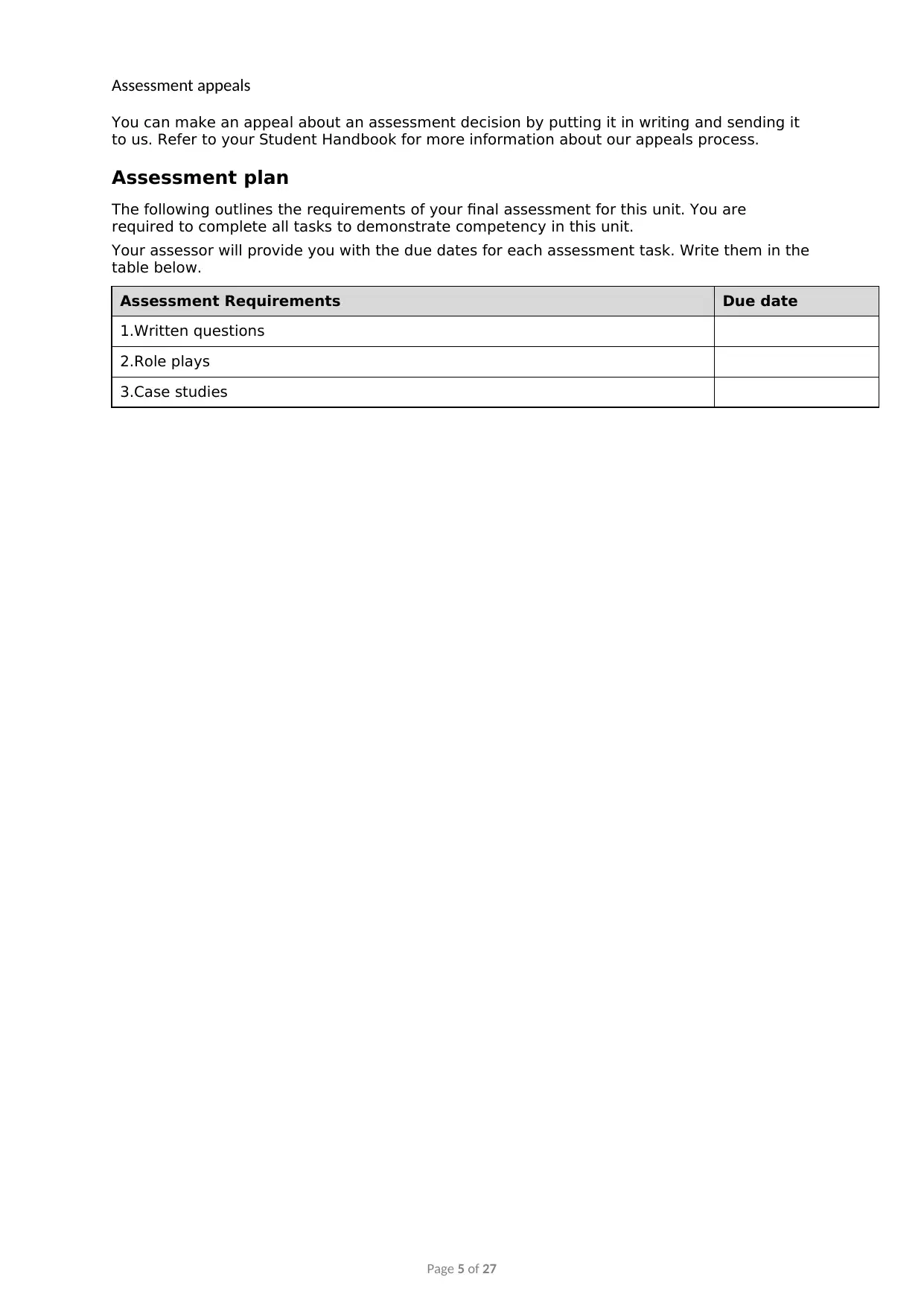
Assessment appeals
You can make an appeal about an assessment decision by putting it in writing and sending it
to us. Refer to your Student Handbook for more information about our appeals process.
Assessment plan
The following outlines the requirements of your final assessment for this unit. You are
required to complete all tasks to demonstrate competency in this unit.
Your assessor will provide you with the due dates for each assessment task. Write them in the
table below.
Assessment Requirements Due date
1.Written questions
2.Role plays
3.Case studies
Page 5 of 27
You can make an appeal about an assessment decision by putting it in writing and sending it
to us. Refer to your Student Handbook for more information about our appeals process.
Assessment plan
The following outlines the requirements of your final assessment for this unit. You are
required to complete all tasks to demonstrate competency in this unit.
Your assessor will provide you with the due dates for each assessment task. Write them in the
table below.
Assessment Requirements Due date
1.Written questions
2.Role plays
3.Case studies
Page 5 of 27
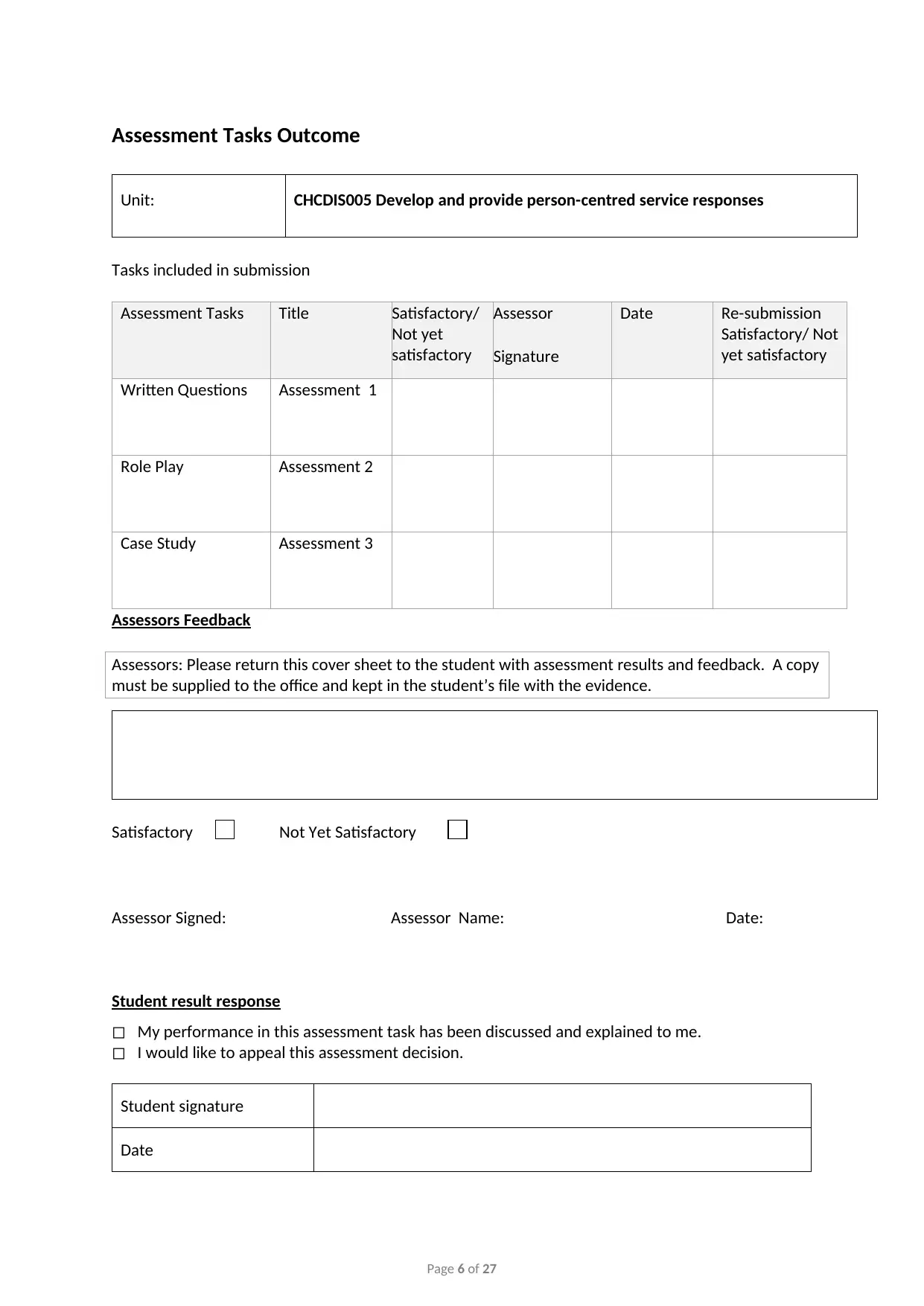
Assessment Tasks Outcome
Unit: CHCDIS005 Develop and provide person-centred service responses
Tasks included in submission
Assessment Tasks Title Satisfactory/
Not yet
satisfactory
Assessor
Signature
Date Re-submission
Satisfactory/ Not
yet satisfactory
Written Questions Assessment 1
Role Play Assessment 2
Case Study Assessment 3
Assessors Feedback
Assessors: Please return this cover sheet to the student with assessment results and feedback. A copy
must be supplied to the office and kept in the student’s file with the evidence.
Satisfactory Not Yet Satisfactory
Assessor Signed: Assessor Name: Date:
Student result response
◻ My performance in this assessment task has been discussed and explained to me.
◻ I would like to appeal this assessment decision.
Student signature
Date
Page 6 of 27
Unit: CHCDIS005 Develop and provide person-centred service responses
Tasks included in submission
Assessment Tasks Title Satisfactory/
Not yet
satisfactory
Assessor
Signature
Date Re-submission
Satisfactory/ Not
yet satisfactory
Written Questions Assessment 1
Role Play Assessment 2
Case Study Assessment 3
Assessors Feedback
Assessors: Please return this cover sheet to the student with assessment results and feedback. A copy
must be supplied to the office and kept in the student’s file with the evidence.
Satisfactory Not Yet Satisfactory
Assessor Signed: Assessor Name: Date:
Student result response
◻ My performance in this assessment task has been discussed and explained to me.
◻ I would like to appeal this assessment decision.
Student signature
Date
Page 6 of 27
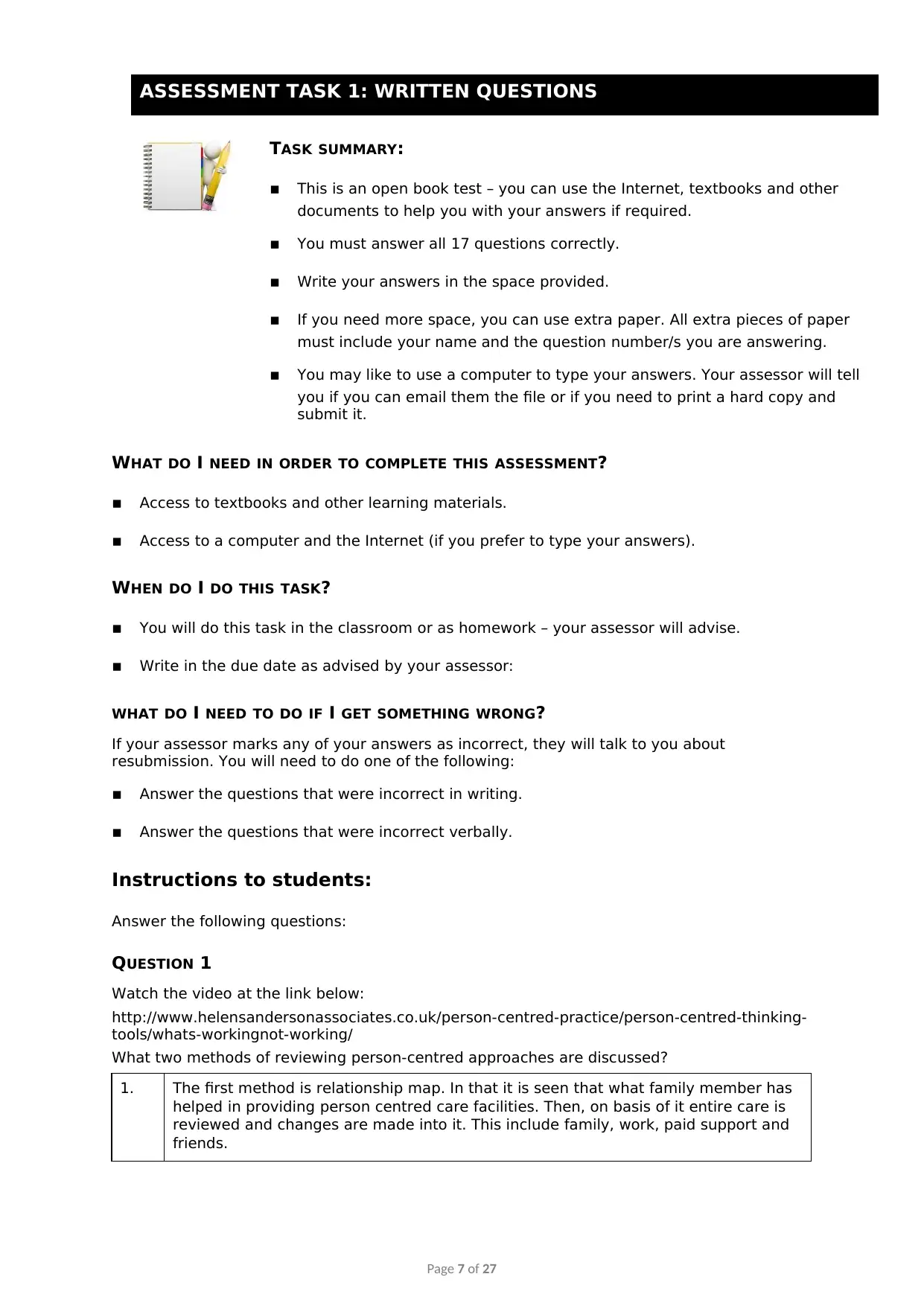
ASSESSMENT TASK 1: WRITTEN QUESTIONS
TASK SUMMARY:
▪ This is an open book test – you can use the Internet, textbooks and other
documents to help you with your answers if required.
▪ You must answer all 17 questions correctly.
▪ Write your answers in the space provided.
▪ If you need more space, you can use extra paper. All extra pieces of paper
must include your name and the question number/s you are answering.
▪ You may like to use a computer to type your answers. Your assessor will tell
you if you can email them the file or if you need to print a hard copy and
submit it.
WHAT DO I NEED IN ORDER TO COMPLETE THIS ASSESSMENT?
▪ Access to textbooks and other learning materials.
▪ Access to a computer and the Internet (if you prefer to type your answers).
WHEN DO I DO THIS TASK?
▪ You will do this task in the classroom or as homework – your assessor will advise.
▪ Write in the due date as advised by your assessor:
WHAT DO I NEED TO DO IF I GET SOMETHING WRONG?
If your assessor marks any of your answers as incorrect, they will talk to you about
resubmission. You will need to do one of the following:
▪ Answer the questions that were incorrect in writing.
▪ Answer the questions that were incorrect verbally.
Instructions to students:
Answer the following questions:
QUESTION 1
Watch the video at the link below:
http://www.helensandersonassociates.co.uk/person-centred-practice/person-centred-thinking-
tools/whats-workingnot-working/
What two methods of reviewing person-centred approaches are discussed?
1. The first method is relationship map. In that it is seen that what family member has
helped in providing person centred care facilities. Then, on basis of it entire care is
reviewed and changes are made into it. This include family, work, paid support and
friends.
Page 7 of 27
TASK SUMMARY:
▪ This is an open book test – you can use the Internet, textbooks and other
documents to help you with your answers if required.
▪ You must answer all 17 questions correctly.
▪ Write your answers in the space provided.
▪ If you need more space, you can use extra paper. All extra pieces of paper
must include your name and the question number/s you are answering.
▪ You may like to use a computer to type your answers. Your assessor will tell
you if you can email them the file or if you need to print a hard copy and
submit it.
WHAT DO I NEED IN ORDER TO COMPLETE THIS ASSESSMENT?
▪ Access to textbooks and other learning materials.
▪ Access to a computer and the Internet (if you prefer to type your answers).
WHEN DO I DO THIS TASK?
▪ You will do this task in the classroom or as homework – your assessor will advise.
▪ Write in the due date as advised by your assessor:
WHAT DO I NEED TO DO IF I GET SOMETHING WRONG?
If your assessor marks any of your answers as incorrect, they will talk to you about
resubmission. You will need to do one of the following:
▪ Answer the questions that were incorrect in writing.
▪ Answer the questions that were incorrect verbally.
Instructions to students:
Answer the following questions:
QUESTION 1
Watch the video at the link below:
http://www.helensandersonassociates.co.uk/person-centred-practice/person-centred-thinking-
tools/whats-workingnot-working/
What two methods of reviewing person-centred approaches are discussed?
1. The first method is relationship map. In that it is seen that what family member has
helped in providing person centred care facilities. Then, on basis of it entire care is
reviewed and changes are made into it. This include family, work, paid support and
friends.
Page 7 of 27
Paraphrase This Document
Need a fresh take? Get an instant paraphrase of this document with our AI Paraphraser
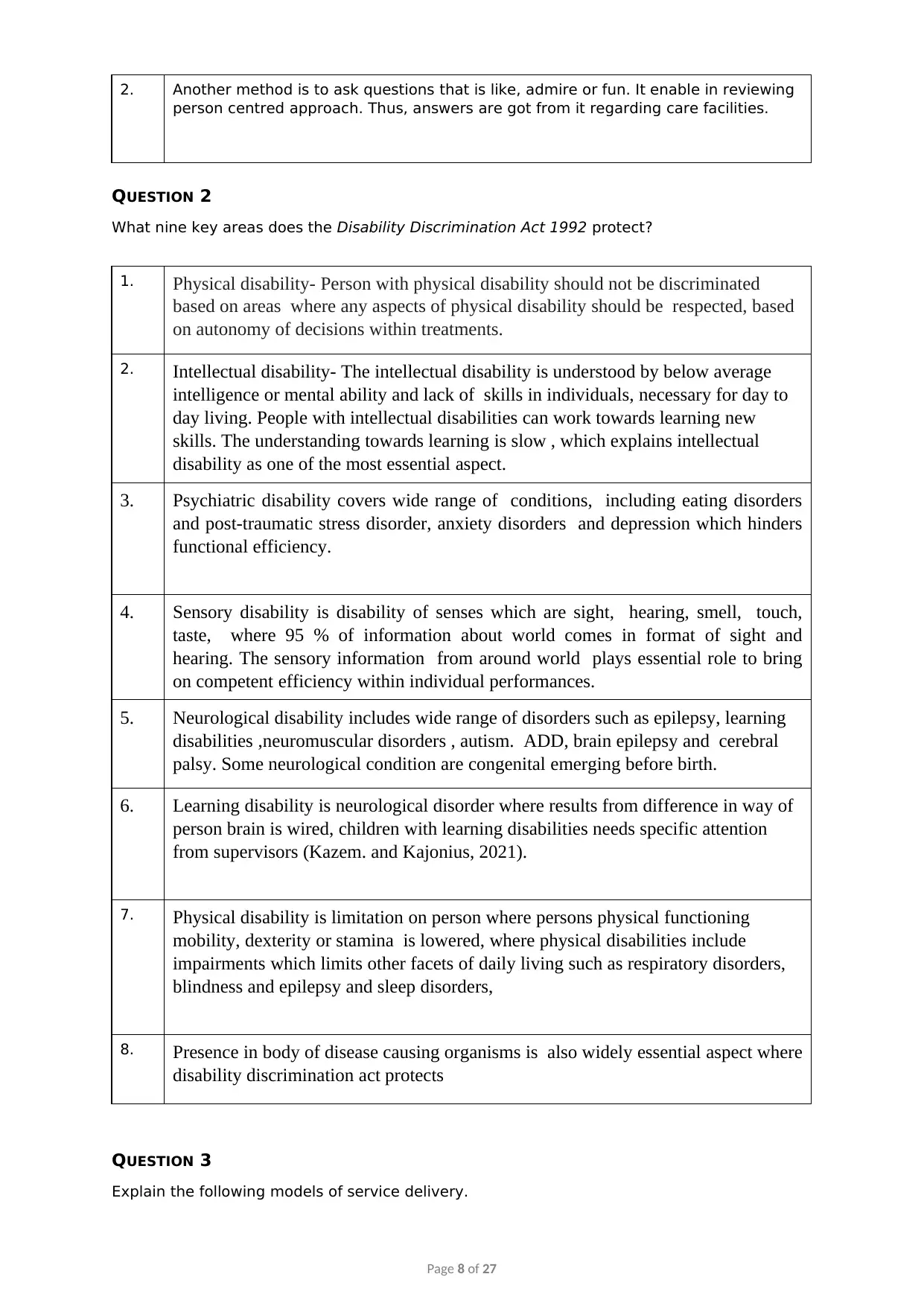
2. Another method is to ask questions that is like, admire or fun. It enable in reviewing
person centred approach. Thus, answers are got from it regarding care facilities.
QUESTION 2
What nine key areas does the Disability Discrimination Act 1992 protect?
1. Physical disability- Person with physical disability should not be discriminated
based on areas where any aspects of physical disability should be respected, based
on autonomy of decisions within treatments.
2. Intellectual disability- The intellectual disability is understood by below average
intelligence or mental ability and lack of skills in individuals, necessary for day to
day living. People with intellectual disabilities can work towards learning new
skills. The understanding towards learning is slow , which explains intellectual
disability as one of the most essential aspect.
3. Psychiatric disability covers wide range of conditions, including eating disorders
and post-traumatic stress disorder, anxiety disorders and depression which hinders
functional efficiency.
4. Sensory disability is disability of senses which are sight, hearing, smell, touch,
taste, where 95 % of information about world comes in format of sight and
hearing. The sensory information from around world plays essential role to bring
on competent efficiency within individual performances.
5. Neurological disability includes wide range of disorders such as epilepsy, learning
disabilities ,neuromuscular disorders , autism. ADD, brain epilepsy and cerebral
palsy. Some neurological condition are congenital emerging before birth.
6. Learning disability is neurological disorder where results from difference in way of
person brain is wired, children with learning disabilities needs specific attention
from supervisors (Kazem. and Kajonius, 2021).
7. Physical disability is limitation on person where persons physical functioning
mobility, dexterity or stamina is lowered, where physical disabilities include
impairments which limits other facets of daily living such as respiratory disorders,
blindness and epilepsy and sleep disorders,
8. Presence in body of disease causing organisms is also widely essential aspect where
disability discrimination act protects
QUESTION 3
Explain the following models of service delivery.
Page 8 of 27
person centred approach. Thus, answers are got from it regarding care facilities.
QUESTION 2
What nine key areas does the Disability Discrimination Act 1992 protect?
1. Physical disability- Person with physical disability should not be discriminated
based on areas where any aspects of physical disability should be respected, based
on autonomy of decisions within treatments.
2. Intellectual disability- The intellectual disability is understood by below average
intelligence or mental ability and lack of skills in individuals, necessary for day to
day living. People with intellectual disabilities can work towards learning new
skills. The understanding towards learning is slow , which explains intellectual
disability as one of the most essential aspect.
3. Psychiatric disability covers wide range of conditions, including eating disorders
and post-traumatic stress disorder, anxiety disorders and depression which hinders
functional efficiency.
4. Sensory disability is disability of senses which are sight, hearing, smell, touch,
taste, where 95 % of information about world comes in format of sight and
hearing. The sensory information from around world plays essential role to bring
on competent efficiency within individual performances.
5. Neurological disability includes wide range of disorders such as epilepsy, learning
disabilities ,neuromuscular disorders , autism. ADD, brain epilepsy and cerebral
palsy. Some neurological condition are congenital emerging before birth.
6. Learning disability is neurological disorder where results from difference in way of
person brain is wired, children with learning disabilities needs specific attention
from supervisors (Kazem. and Kajonius, 2021).
7. Physical disability is limitation on person where persons physical functioning
mobility, dexterity or stamina is lowered, where physical disabilities include
impairments which limits other facets of daily living such as respiratory disorders,
blindness and epilepsy and sleep disorders,
8. Presence in body of disease causing organisms is also widely essential aspect where
disability discrimination act protects
QUESTION 3
Explain the following models of service delivery.
Page 8 of 27

Model Description
Least Restrictive Principle
(LRP) The Least Restrictive alternative model explains principle
ensuring person is able to maintain their autonomy, where it
is also about state intervening as narrow way as possible. It
enables to take autonomy and full control in decision
related to care, treatments which enhances respect within
individual.
Person Centred Planning
(PCP) Person centred planning is process for selecting and
organising services and supports that an older adult or
person with disability may need to live in community.
Where, model explains it is process directly interrelated by
person who receives the support.
Transitional (T) Transitional care refers to coordination and continuity of
healthcare during movement from one healthcare setting to
either another or to home, called transitional care.
Healthcare practitioners as their condition and care need
changes during course of chronic or acute illness. Old
adults who suffer from variety of health conditions often
need health care services in various settings to meet their
respective needs. For young people focus is on moving
successfully from child to adult health services (Kohek,
Edwards and Zwicker, J2021).
QUESTION 4
According to the National Standards for Disability Services in Australia, what are the six
standards that apply to disability service providers?
1. Rights are protected with application to national standards for disability services
2. Participation and Inclusion protected with application to national standards for
disability services
3.
Individual Outcomes protected with application to national standards for disability
services
4. Feedback and Complaints are protected with application to national standards for
disability services
5. Service Access is another aspect protected with application to national standards
for disability services
6. Service Management is also protected with application to national standards for
disability services
Page 9 of 27
Least Restrictive Principle
(LRP) The Least Restrictive alternative model explains principle
ensuring person is able to maintain their autonomy, where it
is also about state intervening as narrow way as possible. It
enables to take autonomy and full control in decision
related to care, treatments which enhances respect within
individual.
Person Centred Planning
(PCP) Person centred planning is process for selecting and
organising services and supports that an older adult or
person with disability may need to live in community.
Where, model explains it is process directly interrelated by
person who receives the support.
Transitional (T) Transitional care refers to coordination and continuity of
healthcare during movement from one healthcare setting to
either another or to home, called transitional care.
Healthcare practitioners as their condition and care need
changes during course of chronic or acute illness. Old
adults who suffer from variety of health conditions often
need health care services in various settings to meet their
respective needs. For young people focus is on moving
successfully from child to adult health services (Kohek,
Edwards and Zwicker, J2021).
QUESTION 4
According to the National Standards for Disability Services in Australia, what are the six
standards that apply to disability service providers?
1. Rights are protected with application to national standards for disability services
2. Participation and Inclusion protected with application to national standards for
disability services
3.
Individual Outcomes protected with application to national standards for disability
services
4. Feedback and Complaints are protected with application to national standards for
disability services
5. Service Access is another aspect protected with application to national standards
for disability services
6. Service Management is also protected with application to national standards for
disability services
Page 9 of 27
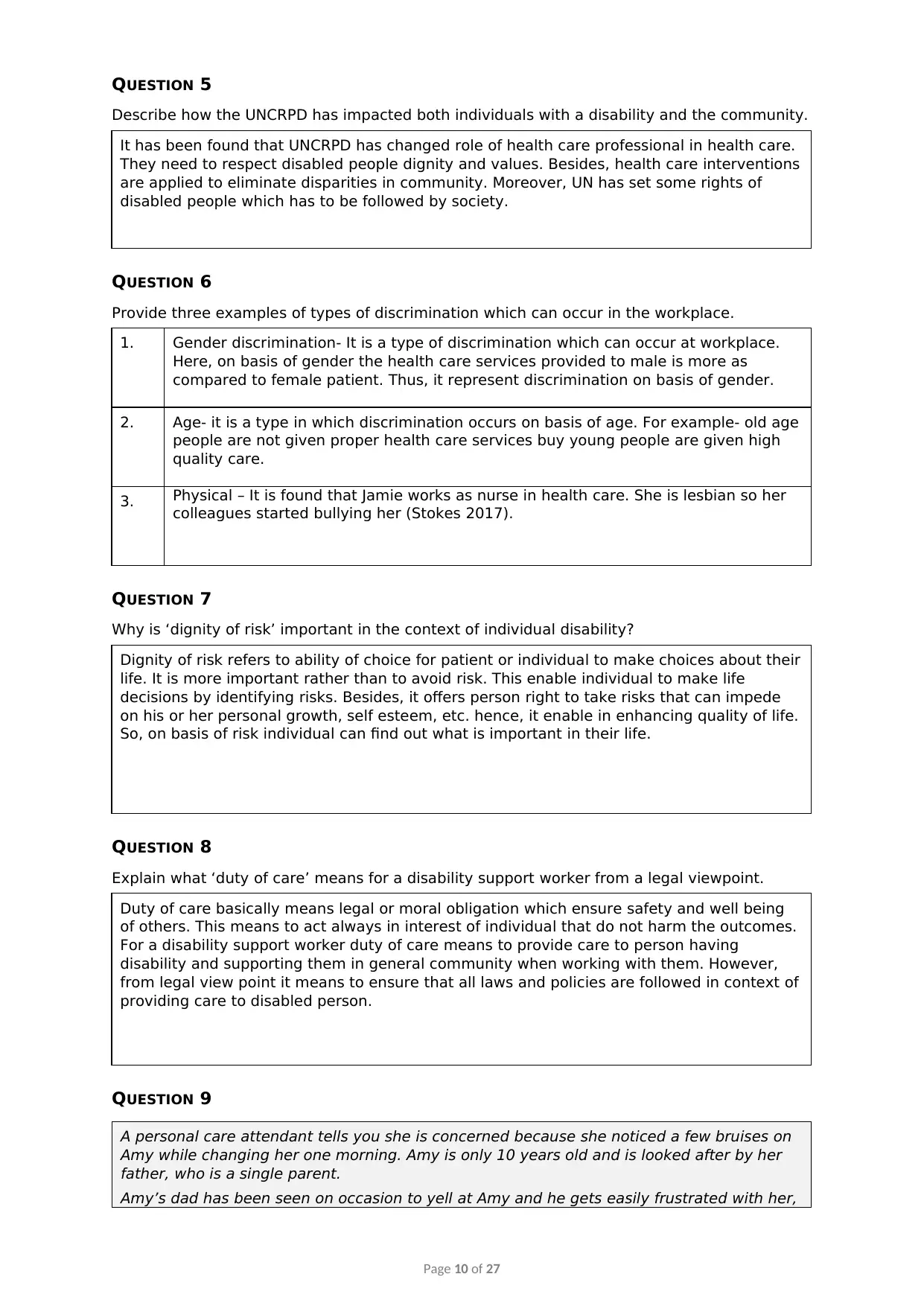
QUESTION 5
Describe how the UNCRPD has impacted both individuals with a disability and the community.
It has been found that UNCRPD has changed role of health care professional in health care.
They need to respect disabled people dignity and values. Besides, health care interventions
are applied to eliminate disparities in community. Moreover, UN has set some rights of
disabled people which has to be followed by society.
QUESTION 6
Provide three examples of types of discrimination which can occur in the workplace.
1. Gender discrimination- It is a type of discrimination which can occur at workplace.
Here, on basis of gender the health care services provided to male is more as
compared to female patient. Thus, it represent discrimination on basis of gender.
2. Age- it is a type in which discrimination occurs on basis of age. For example- old age
people are not given proper health care services buy young people are given high
quality care.
3. Physical – It is found that Jamie works as nurse in health care. She is lesbian so her
colleagues started bullying her (Stokes 2017).
QUESTION 7
Why is ‘dignity of risk’ important in the context of individual disability?
Dignity of risk refers to ability of choice for patient or individual to make choices about their
life. It is more important rather than to avoid risk. This enable individual to make life
decisions by identifying risks. Besides, it offers person right to take risks that can impede
on his or her personal growth, self esteem, etc. hence, it enable in enhancing quality of life.
So, on basis of risk individual can find out what is important in their life.
QUESTION 8
Explain what ‘duty of care’ means for a disability support worker from a legal viewpoint.
Duty of care basically means legal or moral obligation which ensure safety and well being
of others. This means to act always in interest of individual that do not harm the outcomes.
For a disability support worker duty of care means to provide care to person having
disability and supporting them in general community when working with them. However,
from legal view point it means to ensure that all laws and policies are followed in context of
providing care to disabled person.
QUESTION 9
A personal care attendant tells you she is concerned because she noticed a few bruises on
Amy while changing her one morning. Amy is only 10 years old and is looked after by her
father, who is a single parent.
Amy’s dad has been seen on occasion to yell at Amy and he gets easily frustrated with her,
Page 10 of 27
Describe how the UNCRPD has impacted both individuals with a disability and the community.
It has been found that UNCRPD has changed role of health care professional in health care.
They need to respect disabled people dignity and values. Besides, health care interventions
are applied to eliminate disparities in community. Moreover, UN has set some rights of
disabled people which has to be followed by society.
QUESTION 6
Provide three examples of types of discrimination which can occur in the workplace.
1. Gender discrimination- It is a type of discrimination which can occur at workplace.
Here, on basis of gender the health care services provided to male is more as
compared to female patient. Thus, it represent discrimination on basis of gender.
2. Age- it is a type in which discrimination occurs on basis of age. For example- old age
people are not given proper health care services buy young people are given high
quality care.
3. Physical – It is found that Jamie works as nurse in health care. She is lesbian so her
colleagues started bullying her (Stokes 2017).
QUESTION 7
Why is ‘dignity of risk’ important in the context of individual disability?
Dignity of risk refers to ability of choice for patient or individual to make choices about their
life. It is more important rather than to avoid risk. This enable individual to make life
decisions by identifying risks. Besides, it offers person right to take risks that can impede
on his or her personal growth, self esteem, etc. hence, it enable in enhancing quality of life.
So, on basis of risk individual can find out what is important in their life.
QUESTION 8
Explain what ‘duty of care’ means for a disability support worker from a legal viewpoint.
Duty of care basically means legal or moral obligation which ensure safety and well being
of others. This means to act always in interest of individual that do not harm the outcomes.
For a disability support worker duty of care means to provide care to person having
disability and supporting them in general community when working with them. However,
from legal view point it means to ensure that all laws and policies are followed in context of
providing care to disabled person.
QUESTION 9
A personal care attendant tells you she is concerned because she noticed a few bruises on
Amy while changing her one morning. Amy is only 10 years old and is looked after by her
father, who is a single parent.
Amy’s dad has been seen on occasion to yell at Amy and he gets easily frustrated with her,
Page 10 of 27
Secure Best Marks with AI Grader
Need help grading? Try our AI Grader for instant feedback on your assignments.
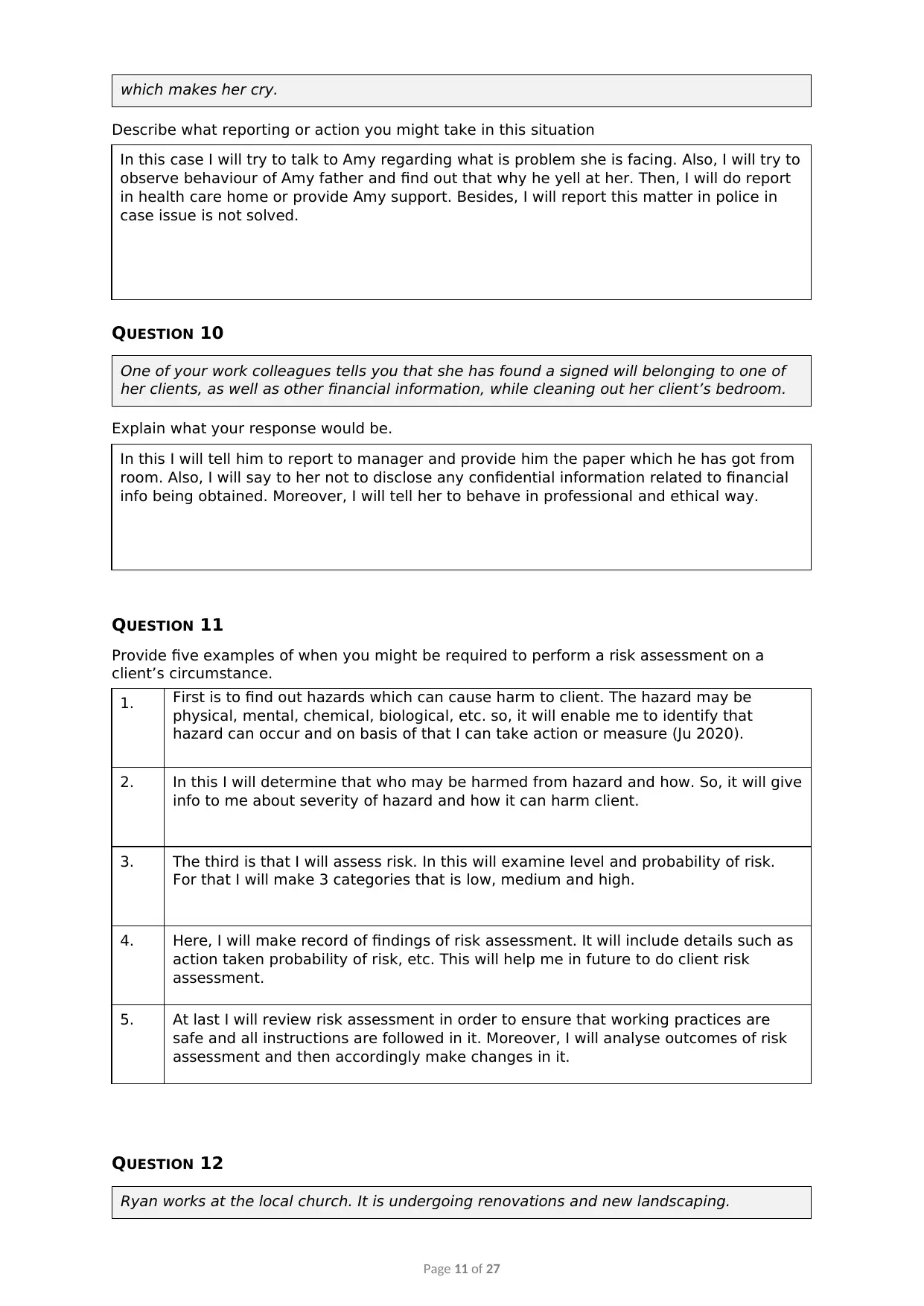
which makes her cry.
Describe what reporting or action you might take in this situation
In this case I will try to talk to Amy regarding what is problem she is facing. Also, I will try to
observe behaviour of Amy father and find out that why he yell at her. Then, I will do report
in health care home or provide Amy support. Besides, I will report this matter in police in
case issue is not solved.
QUESTION 10
One of your work colleagues tells you that she has found a signed will belonging to one of
her clients, as well as other financial information, while cleaning out her client’s bedroom.
Explain what your response would be.
In this I will tell him to report to manager and provide him the paper which he has got from
room. Also, I will say to her not to disclose any confidential information related to financial
info being obtained. Moreover, I will tell her to behave in professional and ethical way.
QUESTION 11
Provide five examples of when you might be required to perform a risk assessment on a
client’s circumstance.
1. First is to find out hazards which can cause harm to client. The hazard may be
physical, mental, chemical, biological, etc. so, it will enable me to identify that
hazard can occur and on basis of that I can take action or measure (Ju 2020).
2. In this I will determine that who may be harmed from hazard and how. So, it will give
info to me about severity of hazard and how it can harm client.
3. The third is that I will assess risk. In this will examine level and probability of risk.
For that I will make 3 categories that is low, medium and high.
4. Here, I will make record of findings of risk assessment. It will include details such as
action taken probability of risk, etc. This will help me in future to do client risk
assessment.
5. At last I will review risk assessment in order to ensure that working practices are
safe and all instructions are followed in it. Moreover, I will analyse outcomes of risk
assessment and then accordingly make changes in it.
QUESTION 12
Ryan works at the local church. It is undergoing renovations and new landscaping.
Page 11 of 27
Describe what reporting or action you might take in this situation
In this case I will try to talk to Amy regarding what is problem she is facing. Also, I will try to
observe behaviour of Amy father and find out that why he yell at her. Then, I will do report
in health care home or provide Amy support. Besides, I will report this matter in police in
case issue is not solved.
QUESTION 10
One of your work colleagues tells you that she has found a signed will belonging to one of
her clients, as well as other financial information, while cleaning out her client’s bedroom.
Explain what your response would be.
In this I will tell him to report to manager and provide him the paper which he has got from
room. Also, I will say to her not to disclose any confidential information related to financial
info being obtained. Moreover, I will tell her to behave in professional and ethical way.
QUESTION 11
Provide five examples of when you might be required to perform a risk assessment on a
client’s circumstance.
1. First is to find out hazards which can cause harm to client. The hazard may be
physical, mental, chemical, biological, etc. so, it will enable me to identify that
hazard can occur and on basis of that I can take action or measure (Ju 2020).
2. In this I will determine that who may be harmed from hazard and how. So, it will give
info to me about severity of hazard and how it can harm client.
3. The third is that I will assess risk. In this will examine level and probability of risk.
For that I will make 3 categories that is low, medium and high.
4. Here, I will make record of findings of risk assessment. It will include details such as
action taken probability of risk, etc. This will help me in future to do client risk
assessment.
5. At last I will review risk assessment in order to ensure that working practices are
safe and all instructions are followed in it. Moreover, I will analyse outcomes of risk
assessment and then accordingly make changes in it.
QUESTION 12
Ryan works at the local church. It is undergoing renovations and new landscaping.
Page 11 of 27
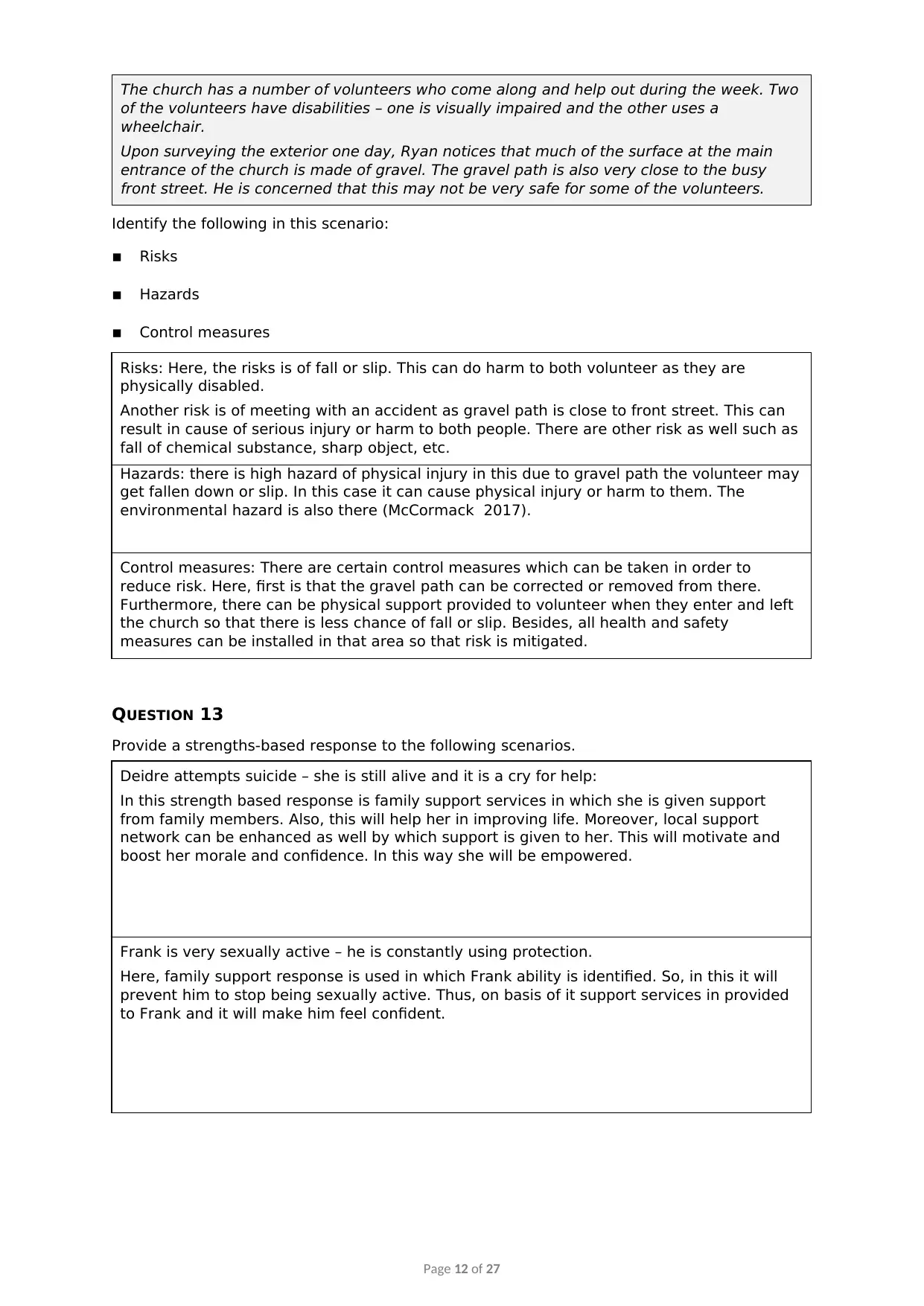
The church has a number of volunteers who come along and help out during the week. Two
of the volunteers have disabilities – one is visually impaired and the other uses a
wheelchair.
Upon surveying the exterior one day, Ryan notices that much of the surface at the main
entrance of the church is made of gravel. The gravel path is also very close to the busy
front street. He is concerned that this may not be very safe for some of the volunteers.
Identify the following in this scenario:
▪ Risks
▪ Hazards
▪ Control measures
Risks: Here, the risks is of fall or slip. This can do harm to both volunteer as they are
physically disabled.
Another risk is of meeting with an accident as gravel path is close to front street. This can
result in cause of serious injury or harm to both people. There are other risk as well such as
fall of chemical substance, sharp object, etc.
Hazards: there is high hazard of physical injury in this due to gravel path the volunteer may
get fallen down or slip. In this case it can cause physical injury or harm to them. The
environmental hazard is also there (McCormack 2017).
Control measures: There are certain control measures which can be taken in order to
reduce risk. Here, first is that the gravel path can be corrected or removed from there.
Furthermore, there can be physical support provided to volunteer when they enter and left
the church so that there is less chance of fall or slip. Besides, all health and safety
measures can be installed in that area so that risk is mitigated.
QUESTION 13
Provide a strengths-based response to the following scenarios.
Deidre attempts suicide – she is still alive and it is a cry for help:
In this strength based response is family support services in which she is given support
from family members. Also, this will help her in improving life. Moreover, local support
network can be enhanced as well by which support is given to her. This will motivate and
boost her morale and confidence. In this way she will be empowered.
Frank is very sexually active – he is constantly using protection.
Here, family support response is used in which Frank ability is identified. So, in this it will
prevent him to stop being sexually active. Thus, on basis of it support services in provided
to Frank and it will make him feel confident.
Page 12 of 27
of the volunteers have disabilities – one is visually impaired and the other uses a
wheelchair.
Upon surveying the exterior one day, Ryan notices that much of the surface at the main
entrance of the church is made of gravel. The gravel path is also very close to the busy
front street. He is concerned that this may not be very safe for some of the volunteers.
Identify the following in this scenario:
▪ Risks
▪ Hazards
▪ Control measures
Risks: Here, the risks is of fall or slip. This can do harm to both volunteer as they are
physically disabled.
Another risk is of meeting with an accident as gravel path is close to front street. This can
result in cause of serious injury or harm to both people. There are other risk as well such as
fall of chemical substance, sharp object, etc.
Hazards: there is high hazard of physical injury in this due to gravel path the volunteer may
get fallen down or slip. In this case it can cause physical injury or harm to them. The
environmental hazard is also there (McCormack 2017).
Control measures: There are certain control measures which can be taken in order to
reduce risk. Here, first is that the gravel path can be corrected or removed from there.
Furthermore, there can be physical support provided to volunteer when they enter and left
the church so that there is less chance of fall or slip. Besides, all health and safety
measures can be installed in that area so that risk is mitigated.
QUESTION 13
Provide a strengths-based response to the following scenarios.
Deidre attempts suicide – she is still alive and it is a cry for help:
In this strength based response is family support services in which she is given support
from family members. Also, this will help her in improving life. Moreover, local support
network can be enhanced as well by which support is given to her. This will motivate and
boost her morale and confidence. In this way she will be empowered.
Frank is very sexually active – he is constantly using protection.
Here, family support response is used in which Frank ability is identified. So, in this it will
prevent him to stop being sexually active. Thus, on basis of it support services in provided
to Frank and it will make him feel confident.
Page 12 of 27
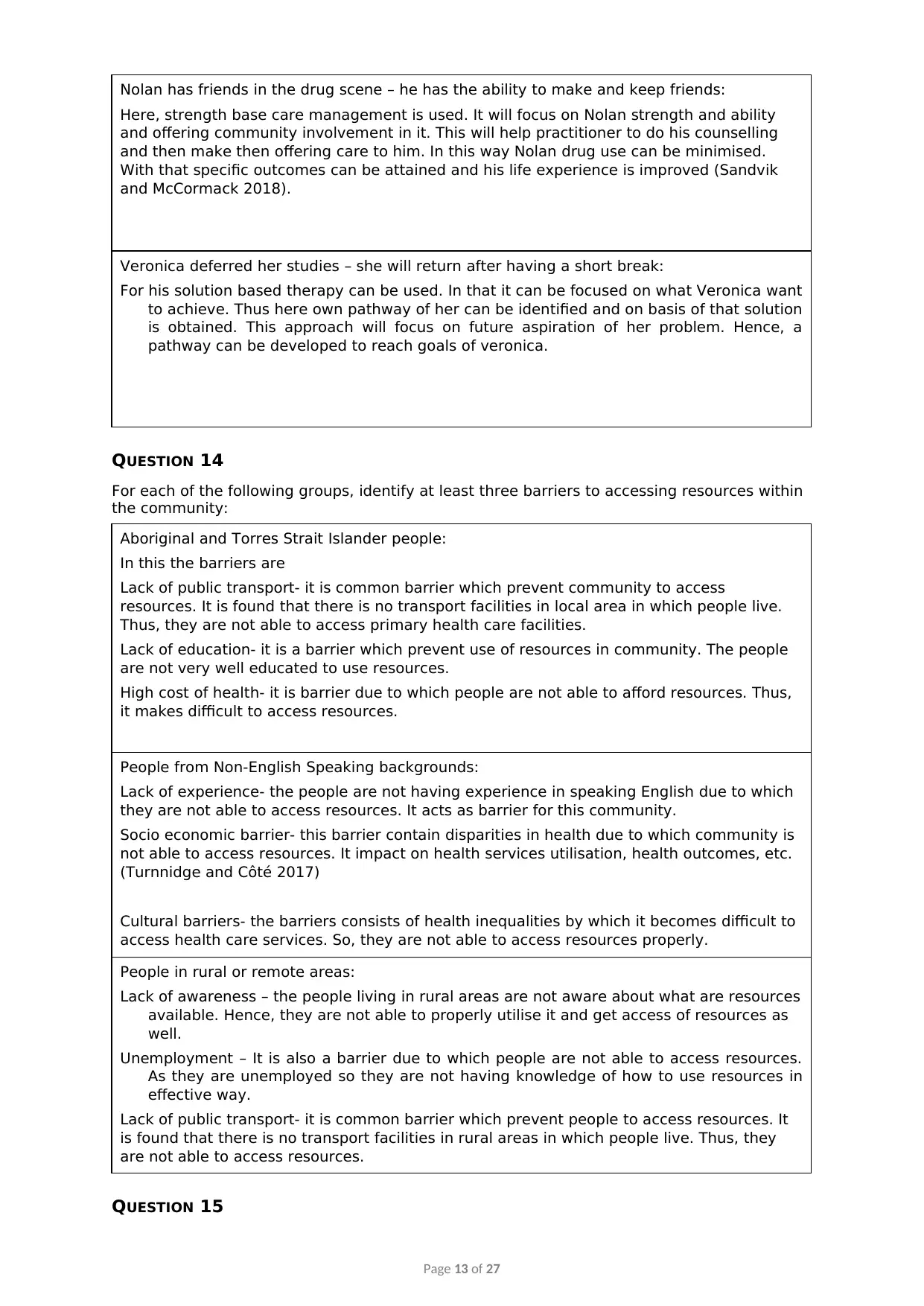
Nolan has friends in the drug scene – he has the ability to make and keep friends:
Here, strength base care management is used. It will focus on Nolan strength and ability
and offering community involvement in it. This will help practitioner to do his counselling
and then make then offering care to him. In this way Nolan drug use can be minimised.
With that specific outcomes can be attained and his life experience is improved (Sandvik
and McCormack 2018).
Veronica deferred her studies – she will return after having a short break:
For his solution based therapy can be used. In that it can be focused on what Veronica want
to achieve. Thus here own pathway of her can be identified and on basis of that solution
is obtained. This approach will focus on future aspiration of her problem. Hence, a
pathway can be developed to reach goals of veronica.
QUESTION 14
For each of the following groups, identify at least three barriers to accessing resources within
the community:
Aboriginal and Torres Strait Islander people:
In this the barriers are
Lack of public transport- it is common barrier which prevent community to access
resources. It is found that there is no transport facilities in local area in which people live.
Thus, they are not able to access primary health care facilities.
Lack of education- it is a barrier which prevent use of resources in community. The people
are not very well educated to use resources.
High cost of health- it is barrier due to which people are not able to afford resources. Thus,
it makes difficult to access resources.
People from Non-English Speaking backgrounds:
Lack of experience- the people are not having experience in speaking English due to which
they are not able to access resources. It acts as barrier for this community.
Socio economic barrier- this barrier contain disparities in health due to which community is
not able to access resources. It impact on health services utilisation, health outcomes, etc.
(Turnnidge and Côté 2017)
Cultural barriers- the barriers consists of health inequalities by which it becomes difficult to
access health care services. So, they are not able to access resources properly.
People in rural or remote areas:
Lack of awareness – the people living in rural areas are not aware about what are resources
available. Hence, they are not able to properly utilise it and get access of resources as
well.
Unemployment – It is also a barrier due to which people are not able to access resources.
As they are unemployed so they are not having knowledge of how to use resources in
effective way.
Lack of public transport- it is common barrier which prevent people to access resources. It
is found that there is no transport facilities in rural areas in which people live. Thus, they
are not able to access resources.
QUESTION 15
Page 13 of 27
Here, strength base care management is used. It will focus on Nolan strength and ability
and offering community involvement in it. This will help practitioner to do his counselling
and then make then offering care to him. In this way Nolan drug use can be minimised.
With that specific outcomes can be attained and his life experience is improved (Sandvik
and McCormack 2018).
Veronica deferred her studies – she will return after having a short break:
For his solution based therapy can be used. In that it can be focused on what Veronica want
to achieve. Thus here own pathway of her can be identified and on basis of that solution
is obtained. This approach will focus on future aspiration of her problem. Hence, a
pathway can be developed to reach goals of veronica.
QUESTION 14
For each of the following groups, identify at least three barriers to accessing resources within
the community:
Aboriginal and Torres Strait Islander people:
In this the barriers are
Lack of public transport- it is common barrier which prevent community to access
resources. It is found that there is no transport facilities in local area in which people live.
Thus, they are not able to access primary health care facilities.
Lack of education- it is a barrier which prevent use of resources in community. The people
are not very well educated to use resources.
High cost of health- it is barrier due to which people are not able to afford resources. Thus,
it makes difficult to access resources.
People from Non-English Speaking backgrounds:
Lack of experience- the people are not having experience in speaking English due to which
they are not able to access resources. It acts as barrier for this community.
Socio economic barrier- this barrier contain disparities in health due to which community is
not able to access resources. It impact on health services utilisation, health outcomes, etc.
(Turnnidge and Côté 2017)
Cultural barriers- the barriers consists of health inequalities by which it becomes difficult to
access health care services. So, they are not able to access resources properly.
People in rural or remote areas:
Lack of awareness – the people living in rural areas are not aware about what are resources
available. Hence, they are not able to properly utilise it and get access of resources as
well.
Unemployment – It is also a barrier due to which people are not able to access resources.
As they are unemployed so they are not having knowledge of how to use resources in
effective way.
Lack of public transport- it is common barrier which prevent people to access resources. It
is found that there is no transport facilities in rural areas in which people live. Thus, they
are not able to access resources.
QUESTION 15
Page 13 of 27
Paraphrase This Document
Need a fresh take? Get an instant paraphrase of this document with our AI Paraphraser
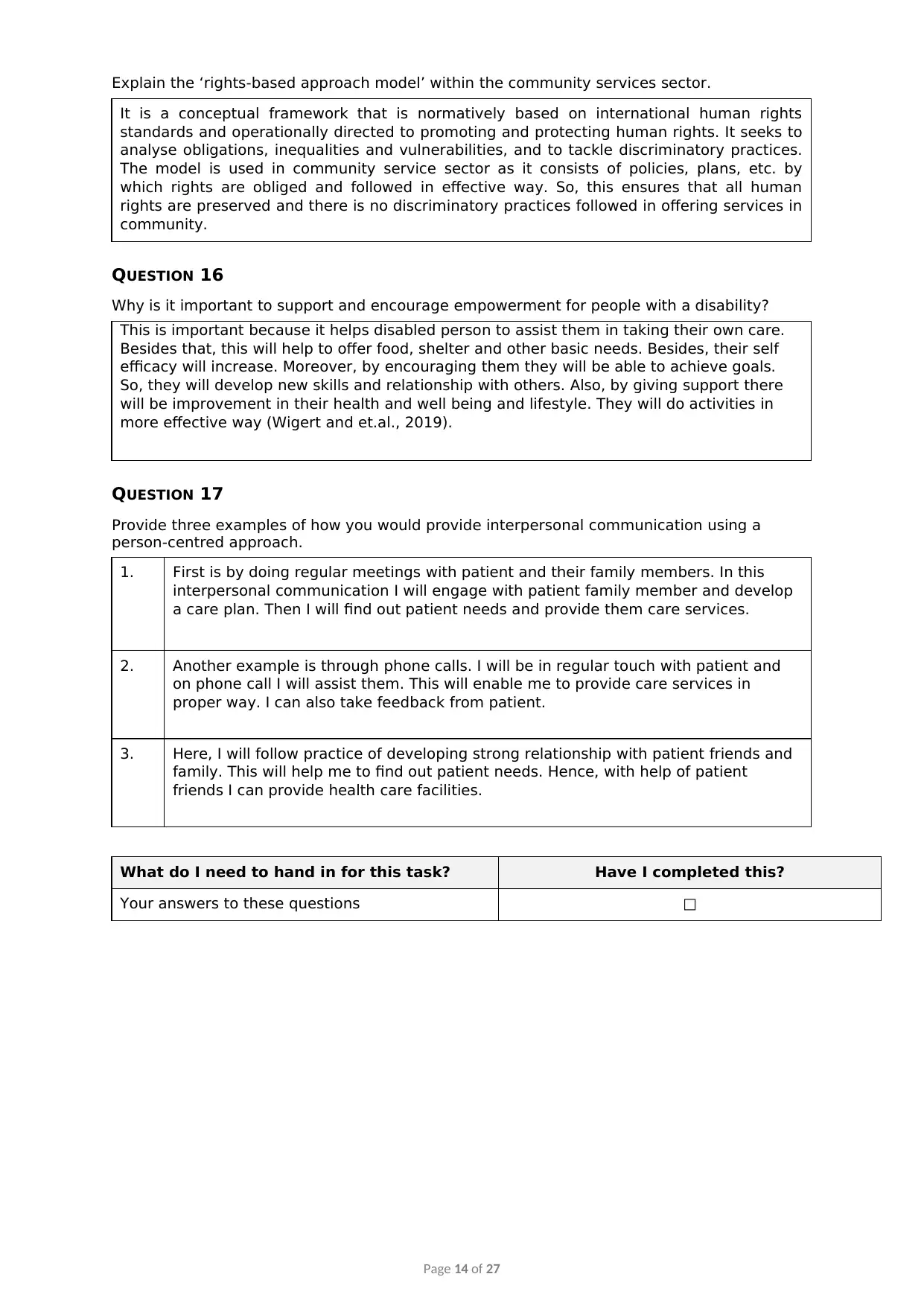
Explain the ‘rights-based approach model’ within the community services sector.
It is a conceptual framework that is normatively based on international human rights
standards and operationally directed to promoting and protecting human rights. It seeks to
analyse obligations, inequalities and vulnerabilities, and to tackle discriminatory practices.
The model is used in community service sector as it consists of policies, plans, etc. by
which rights are obliged and followed in effective way. So, this ensures that all human
rights are preserved and there is no discriminatory practices followed in offering services in
community.
QUESTION 16
Why is it important to support and encourage empowerment for people with a disability?
This is important because it helps disabled person to assist them in taking their own care.
Besides that, this will help to offer food, shelter and other basic needs. Besides, their self
efficacy will increase. Moreover, by encouraging them they will be able to achieve goals.
So, they will develop new skills and relationship with others. Also, by giving support there
will be improvement in their health and well being and lifestyle. They will do activities in
more effective way (Wigert and et.al., 2019).
QUESTION 17
Provide three examples of how you would provide interpersonal communication using a
person-centred approach.
1. First is by doing regular meetings with patient and their family members. In this
interpersonal communication I will engage with patient family member and develop
a care plan. Then I will find out patient needs and provide them care services.
2. Another example is through phone calls. I will be in regular touch with patient and
on phone call I will assist them. This will enable me to provide care services in
proper way. I can also take feedback from patient.
3. Here, I will follow practice of developing strong relationship with patient friends and
family. This will help me to find out patient needs. Hence, with help of patient
friends I can provide health care facilities.
What do I need to hand in for this task? Have I completed this?
Your answers to these questions □
Page 14 of 27
It is a conceptual framework that is normatively based on international human rights
standards and operationally directed to promoting and protecting human rights. It seeks to
analyse obligations, inequalities and vulnerabilities, and to tackle discriminatory practices.
The model is used in community service sector as it consists of policies, plans, etc. by
which rights are obliged and followed in effective way. So, this ensures that all human
rights are preserved and there is no discriminatory practices followed in offering services in
community.
QUESTION 16
Why is it important to support and encourage empowerment for people with a disability?
This is important because it helps disabled person to assist them in taking their own care.
Besides that, this will help to offer food, shelter and other basic needs. Besides, their self
efficacy will increase. Moreover, by encouraging them they will be able to achieve goals.
So, they will develop new skills and relationship with others. Also, by giving support there
will be improvement in their health and well being and lifestyle. They will do activities in
more effective way (Wigert and et.al., 2019).
QUESTION 17
Provide three examples of how you would provide interpersonal communication using a
person-centred approach.
1. First is by doing regular meetings with patient and their family members. In this
interpersonal communication I will engage with patient family member and develop
a care plan. Then I will find out patient needs and provide them care services.
2. Another example is through phone calls. I will be in regular touch with patient and
on phone call I will assist them. This will enable me to provide care services in
proper way. I can also take feedback from patient.
3. Here, I will follow practice of developing strong relationship with patient friends and
family. This will help me to find out patient needs. Hence, with help of patient
friends I can provide health care facilities.
What do I need to hand in for this task? Have I completed this?
Your answers to these questions □
Page 14 of 27
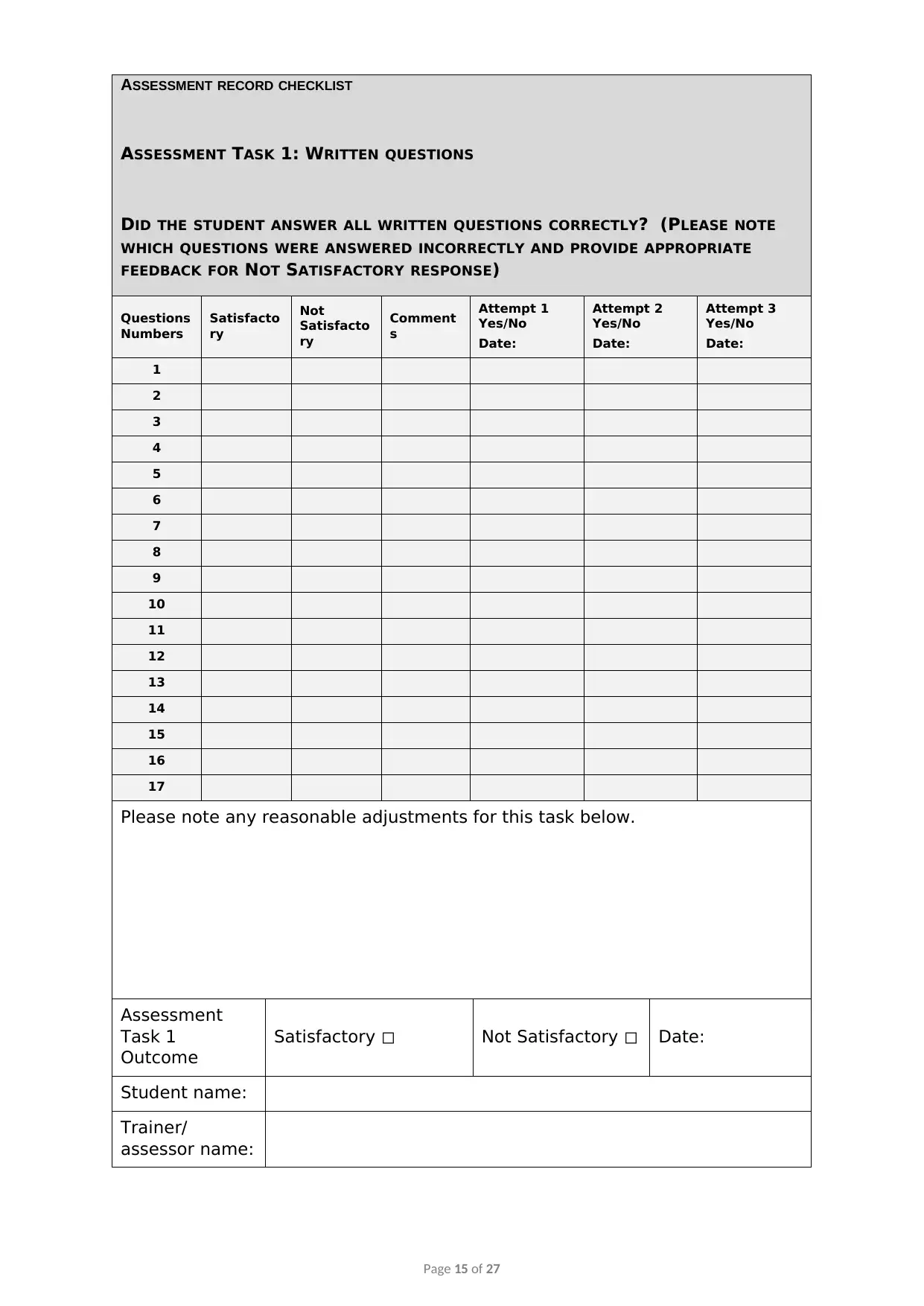
ASSESSMENT RECORD CHECKLIST
ASSESSMENT TASK 1: WRITTEN QUESTIONS
DID THE STUDENT ANSWER ALL WRITTEN QUESTIONS CORRECTLY? (PLEASE NOTE
WHICH QUESTIONS WERE ANSWERED INCORRECTLY AND PROVIDE APPROPRIATE
FEEDBACK FOR NOT SATISFACTORY RESPONSE)
Questions
Numbers
Satisfacto
ry
Not
Satisfacto
ry
Comment
s
Attempt 1
Yes/No
Date:
Attempt 2
Yes/No
Date:
Attempt 3
Yes/No
Date:
1
2
3
4
5
6
7
8
9
10
11
12
13
14
15
16
17
Please note any reasonable adjustments for this task below.
Assessment
Task 1
Outcome
Satisfactory ◻ Not Satisfactory ◻ Date:
Student name:
Trainer/
assessor name:
Page 15 of 27
ASSESSMENT TASK 1: WRITTEN QUESTIONS
DID THE STUDENT ANSWER ALL WRITTEN QUESTIONS CORRECTLY? (PLEASE NOTE
WHICH QUESTIONS WERE ANSWERED INCORRECTLY AND PROVIDE APPROPRIATE
FEEDBACK FOR NOT SATISFACTORY RESPONSE)
Questions
Numbers
Satisfacto
ry
Not
Satisfacto
ry
Comment
s
Attempt 1
Yes/No
Date:
Attempt 2
Yes/No
Date:
Attempt 3
Yes/No
Date:
1
2
3
4
5
6
7
8
9
10
11
12
13
14
15
16
17
Please note any reasonable adjustments for this task below.
Assessment
Task 1
Outcome
Satisfactory ◻ Not Satisfactory ◻ Date:
Student name:
Trainer/
assessor name:
Page 15 of 27
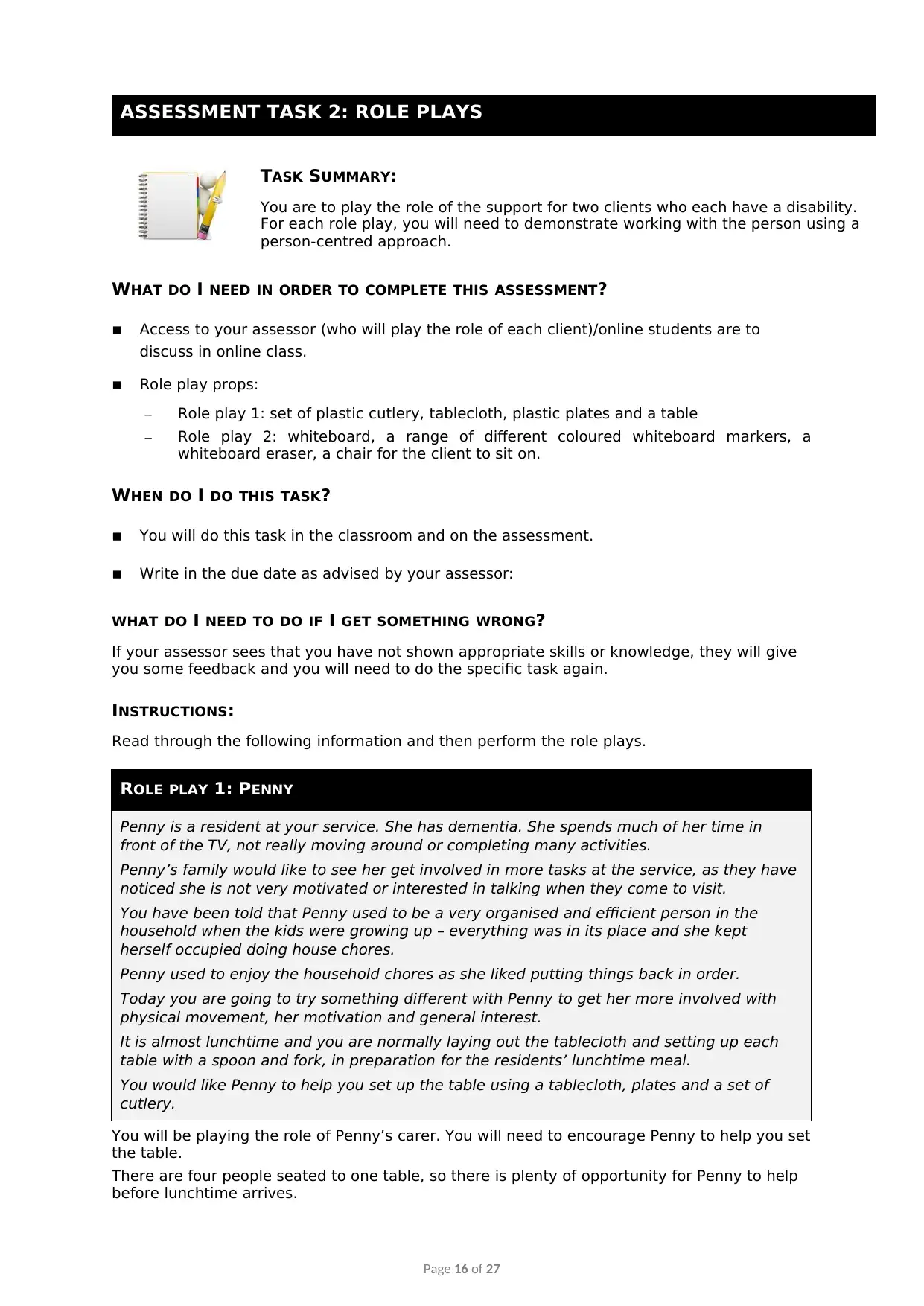
ASSESSMENT TASK 2: ROLE PLAYS
TASK SUMMARY:
You are to play the role of the support for two clients who each have a disability.
For each role play, you will need to demonstrate working with the person using a
person-centred approach.
WHAT DO I NEED IN ORDER TO COMPLETE THIS ASSESSMENT?
▪ Access to your assessor (who will play the role of each client)/online students are to
discuss in online class.
▪ Role play props:
– Role play 1: set of plastic cutlery, tablecloth, plastic plates and a table
– Role play 2: whiteboard, a range of different coloured whiteboard markers, a
whiteboard eraser, a chair for the client to sit on.
WHEN DO I DO THIS TASK?
▪ You will do this task in the classroom and on the assessment.
▪ Write in the due date as advised by your assessor:
WHAT DO I NEED TO DO IF I GET SOMETHING WRONG?
If your assessor sees that you have not shown appropriate skills or knowledge, they will give
you some feedback and you will need to do the specific task again.
INSTRUCTIONS:
Read through the following information and then perform the role plays.
ROLE PLAY 1: PENNY
Penny is a resident at your service. She has dementia. She spends much of her time in
front of the TV, not really moving around or completing many activities.
Penny’s family would like to see her get involved in more tasks at the service, as they have
noticed she is not very motivated or interested in talking when they come to visit.
You have been told that Penny used to be a very organised and efficient person in the
household when the kids were growing up – everything was in its place and she kept
herself occupied doing house chores.
Penny used to enjoy the household chores as she liked putting things back in order.
Today you are going to try something different with Penny to get her more involved with
physical movement, her motivation and general interest.
It is almost lunchtime and you are normally laying out the tablecloth and setting up each
table with a spoon and fork, in preparation for the residents’ lunchtime meal.
You would like Penny to help you set up the table using a tablecloth, plates and a set of
cutlery.
You will be playing the role of Penny’s carer. You will need to encourage Penny to help you set
the table.
There are four people seated to one table, so there is plenty of opportunity for Penny to help
before lunchtime arrives.
Page 16 of 27
TASK SUMMARY:
You are to play the role of the support for two clients who each have a disability.
For each role play, you will need to demonstrate working with the person using a
person-centred approach.
WHAT DO I NEED IN ORDER TO COMPLETE THIS ASSESSMENT?
▪ Access to your assessor (who will play the role of each client)/online students are to
discuss in online class.
▪ Role play props:
– Role play 1: set of plastic cutlery, tablecloth, plastic plates and a table
– Role play 2: whiteboard, a range of different coloured whiteboard markers, a
whiteboard eraser, a chair for the client to sit on.
WHEN DO I DO THIS TASK?
▪ You will do this task in the classroom and on the assessment.
▪ Write in the due date as advised by your assessor:
WHAT DO I NEED TO DO IF I GET SOMETHING WRONG?
If your assessor sees that you have not shown appropriate skills or knowledge, they will give
you some feedback and you will need to do the specific task again.
INSTRUCTIONS:
Read through the following information and then perform the role plays.
ROLE PLAY 1: PENNY
Penny is a resident at your service. She has dementia. She spends much of her time in
front of the TV, not really moving around or completing many activities.
Penny’s family would like to see her get involved in more tasks at the service, as they have
noticed she is not very motivated or interested in talking when they come to visit.
You have been told that Penny used to be a very organised and efficient person in the
household when the kids were growing up – everything was in its place and she kept
herself occupied doing house chores.
Penny used to enjoy the household chores as she liked putting things back in order.
Today you are going to try something different with Penny to get her more involved with
physical movement, her motivation and general interest.
It is almost lunchtime and you are normally laying out the tablecloth and setting up each
table with a spoon and fork, in preparation for the residents’ lunchtime meal.
You would like Penny to help you set up the table using a tablecloth, plates and a set of
cutlery.
You will be playing the role of Penny’s carer. You will need to encourage Penny to help you set
the table.
There are four people seated to one table, so there is plenty of opportunity for Penny to help
before lunchtime arrives.
Page 16 of 27
Secure Best Marks with AI Grader
Need help grading? Try our AI Grader for instant feedback on your assignments.
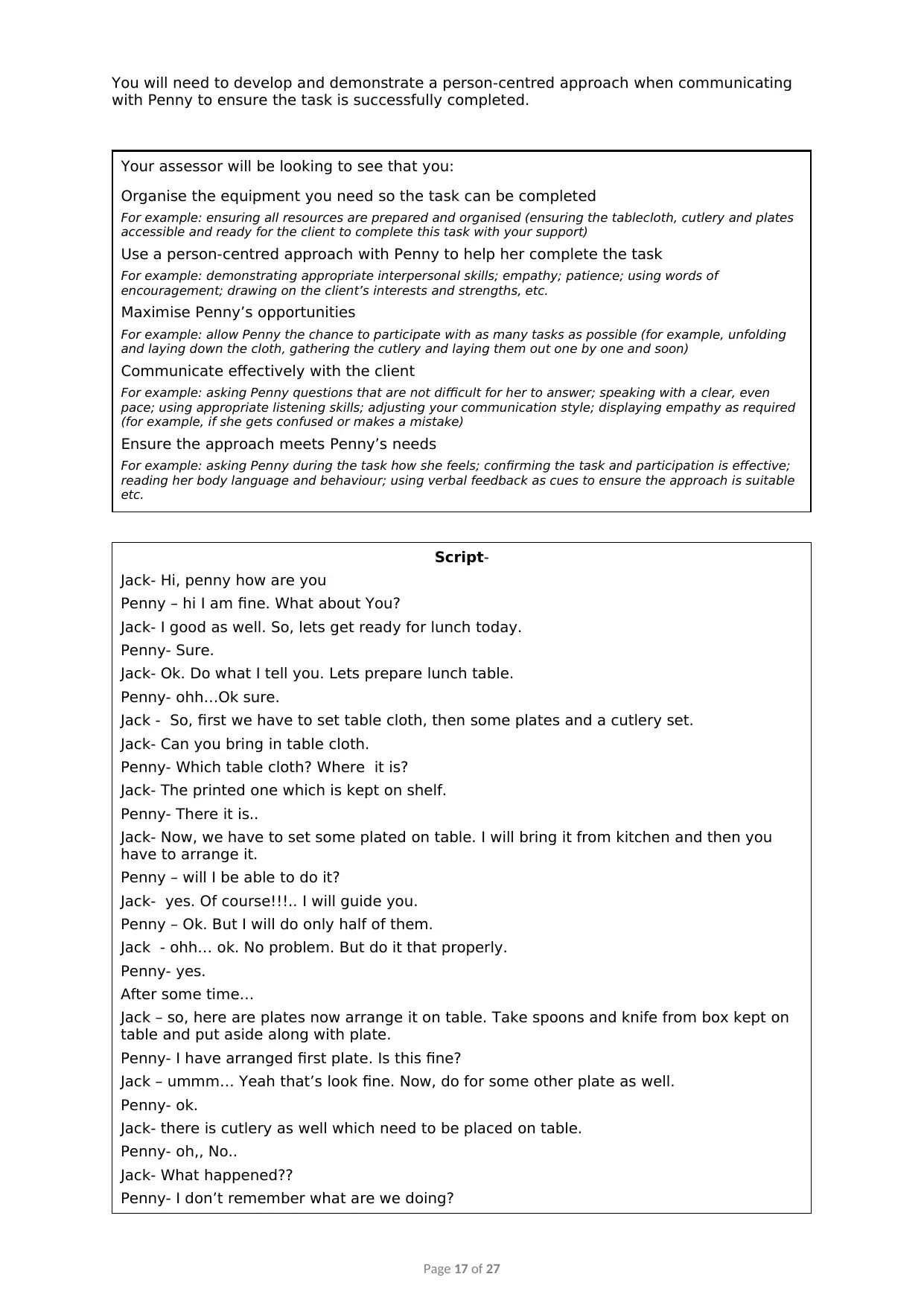
You will need to develop and demonstrate a person-centred approach when communicating
with Penny to ensure the task is successfully completed.
Your assessor will be looking to see that you:
Organise the equipment you need so the task can be completed
For example: ensuring all resources are prepared and organised (ensuring the tablecloth, cutlery and plates
accessible and ready for the client to complete this task with your support)
Use a person-centred approach with Penny to help her complete the task
For example: demonstrating appropriate interpersonal skills; empathy; patience; using words of
encouragement; drawing on the client’s interests and strengths, etc.
Maximise Penny’s opportunities
For example: allow Penny the chance to participate with as many tasks as possible (for example, unfolding
and laying down the cloth, gathering the cutlery and laying them out one by one and soon)
Communicate effectively with the client
For example: asking Penny questions that are not difficult for her to answer; speaking with a clear, even
pace; using appropriate listening skills; adjusting your communication style; displaying empathy as required
(for example, if she gets confused or makes a mistake)
Ensure the approach meets Penny’s needs
For example: asking Penny during the task how she feels; confirming the task and participation is effective;
reading her body language and behaviour; using verbal feedback as cues to ensure the approach is suitable
etc.
Script-
Jack- Hi, penny how are you
Penny – hi I am fine. What about You?
Jack- I good as well. So, lets get ready for lunch today.
Penny- Sure.
Jack- Ok. Do what I tell you. Lets prepare lunch table.
Penny- ohh…Ok sure.
Jack - So, first we have to set table cloth, then some plates and a cutlery set.
Jack- Can you bring in table cloth.
Penny- Which table cloth? Where it is?
Jack- The printed one which is kept on shelf.
Penny- There it is..
Jack- Now, we have to set some plated on table. I will bring it from kitchen and then you
have to arrange it.
Penny – will I be able to do it?
Jack- yes. Of course!!!.. I will guide you.
Penny – Ok. But I will do only half of them.
Jack - ohh… ok. No problem. But do it that properly.
Penny- yes.
After some time…
Jack – so, here are plates now arrange it on table. Take spoons and knife from box kept on
table and put aside along with plate.
Penny- I have arranged first plate. Is this fine?
Jack – ummm… Yeah that’s look fine. Now, do for some other plate as well.
Penny- ok.
Jack- there is cutlery as well which need to be placed on table.
Penny- oh,, No..
Jack- What happened??
Penny- I don’t remember what are we doing?
Page 17 of 27
with Penny to ensure the task is successfully completed.
Your assessor will be looking to see that you:
Organise the equipment you need so the task can be completed
For example: ensuring all resources are prepared and organised (ensuring the tablecloth, cutlery and plates
accessible and ready for the client to complete this task with your support)
Use a person-centred approach with Penny to help her complete the task
For example: demonstrating appropriate interpersonal skills; empathy; patience; using words of
encouragement; drawing on the client’s interests and strengths, etc.
Maximise Penny’s opportunities
For example: allow Penny the chance to participate with as many tasks as possible (for example, unfolding
and laying down the cloth, gathering the cutlery and laying them out one by one and soon)
Communicate effectively with the client
For example: asking Penny questions that are not difficult for her to answer; speaking with a clear, even
pace; using appropriate listening skills; adjusting your communication style; displaying empathy as required
(for example, if she gets confused or makes a mistake)
Ensure the approach meets Penny’s needs
For example: asking Penny during the task how she feels; confirming the task and participation is effective;
reading her body language and behaviour; using verbal feedback as cues to ensure the approach is suitable
etc.
Script-
Jack- Hi, penny how are you
Penny – hi I am fine. What about You?
Jack- I good as well. So, lets get ready for lunch today.
Penny- Sure.
Jack- Ok. Do what I tell you. Lets prepare lunch table.
Penny- ohh…Ok sure.
Jack - So, first we have to set table cloth, then some plates and a cutlery set.
Jack- Can you bring in table cloth.
Penny- Which table cloth? Where it is?
Jack- The printed one which is kept on shelf.
Penny- There it is..
Jack- Now, we have to set some plated on table. I will bring it from kitchen and then you
have to arrange it.
Penny – will I be able to do it?
Jack- yes. Of course!!!.. I will guide you.
Penny – Ok. But I will do only half of them.
Jack - ohh… ok. No problem. But do it that properly.
Penny- yes.
After some time…
Jack – so, here are plates now arrange it on table. Take spoons and knife from box kept on
table and put aside along with plate.
Penny- I have arranged first plate. Is this fine?
Jack – ummm… Yeah that’s look fine. Now, do for some other plate as well.
Penny- ok.
Jack- there is cutlery as well which need to be placed on table.
Penny- oh,, No..
Jack- What happened??
Penny- I don’t remember what are we doing?
Page 17 of 27
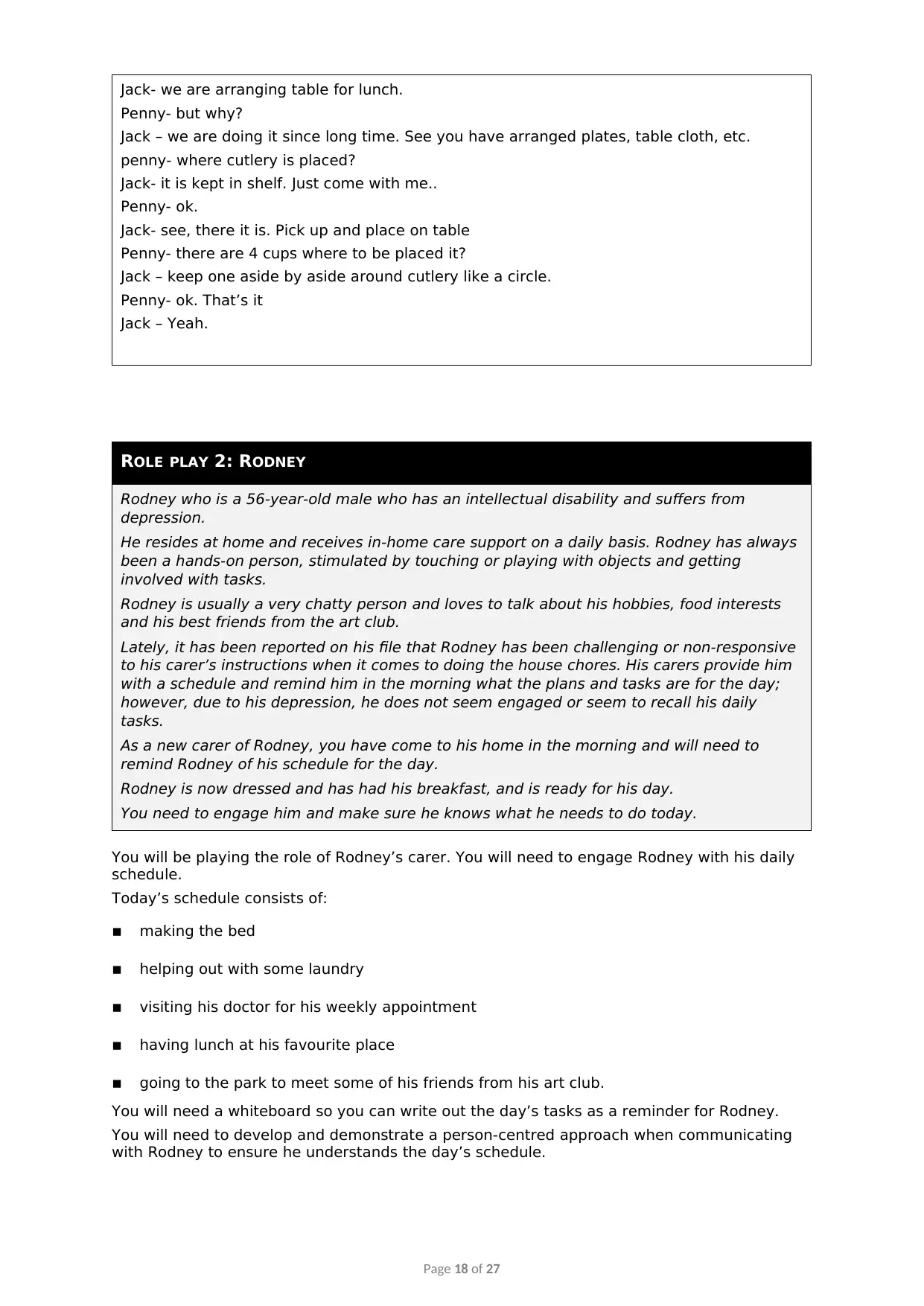
Jack- we are arranging table for lunch.
Penny- but why?
Jack – we are doing it since long time. See you have arranged plates, table cloth, etc.
penny- where cutlery is placed?
Jack- it is kept in shelf. Just come with me..
Penny- ok.
Jack- see, there it is. Pick up and place on table
Penny- there are 4 cups where to be placed it?
Jack – keep one aside by aside around cutlery like a circle.
Penny- ok. That’s it
Jack – Yeah.
ROLE PLAY 2: RODNEY
Rodney who is a 56-year-old male who has an intellectual disability and suffers from
depression.
He resides at home and receives in-home care support on a daily basis. Rodney has always
been a hands-on person, stimulated by touching or playing with objects and getting
involved with tasks.
Rodney is usually a very chatty person and loves to talk about his hobbies, food interests
and his best friends from the art club.
Lately, it has been reported on his file that Rodney has been challenging or non-responsive
to his carer’s instructions when it comes to doing the house chores. His carers provide him
with a schedule and remind him in the morning what the plans and tasks are for the day;
however, due to his depression, he does not seem engaged or seem to recall his daily
tasks.
As a new carer of Rodney, you have come to his home in the morning and will need to
remind Rodney of his schedule for the day.
Rodney is now dressed and has had his breakfast, and is ready for his day.
You need to engage him and make sure he knows what he needs to do today.
You will be playing the role of Rodney’s carer. You will need to engage Rodney with his daily
schedule.
Today’s schedule consists of:
▪ making the bed
▪ helping out with some laundry
▪ visiting his doctor for his weekly appointment
▪ having lunch at his favourite place
▪ going to the park to meet some of his friends from his art club.
You will need a whiteboard so you can write out the day’s tasks as a reminder for Rodney.
You will need to develop and demonstrate a person-centred approach when communicating
with Rodney to ensure he understands the day’s schedule.
Page 18 of 27
Penny- but why?
Jack – we are doing it since long time. See you have arranged plates, table cloth, etc.
penny- where cutlery is placed?
Jack- it is kept in shelf. Just come with me..
Penny- ok.
Jack- see, there it is. Pick up and place on table
Penny- there are 4 cups where to be placed it?
Jack – keep one aside by aside around cutlery like a circle.
Penny- ok. That’s it
Jack – Yeah.
ROLE PLAY 2: RODNEY
Rodney who is a 56-year-old male who has an intellectual disability and suffers from
depression.
He resides at home and receives in-home care support on a daily basis. Rodney has always
been a hands-on person, stimulated by touching or playing with objects and getting
involved with tasks.
Rodney is usually a very chatty person and loves to talk about his hobbies, food interests
and his best friends from the art club.
Lately, it has been reported on his file that Rodney has been challenging or non-responsive
to his carer’s instructions when it comes to doing the house chores. His carers provide him
with a schedule and remind him in the morning what the plans and tasks are for the day;
however, due to his depression, he does not seem engaged or seem to recall his daily
tasks.
As a new carer of Rodney, you have come to his home in the morning and will need to
remind Rodney of his schedule for the day.
Rodney is now dressed and has had his breakfast, and is ready for his day.
You need to engage him and make sure he knows what he needs to do today.
You will be playing the role of Rodney’s carer. You will need to engage Rodney with his daily
schedule.
Today’s schedule consists of:
▪ making the bed
▪ helping out with some laundry
▪ visiting his doctor for his weekly appointment
▪ having lunch at his favourite place
▪ going to the park to meet some of his friends from his art club.
You will need a whiteboard so you can write out the day’s tasks as a reminder for Rodney.
You will need to develop and demonstrate a person-centred approach when communicating
with Rodney to ensure he understands the day’s schedule.
Page 18 of 27
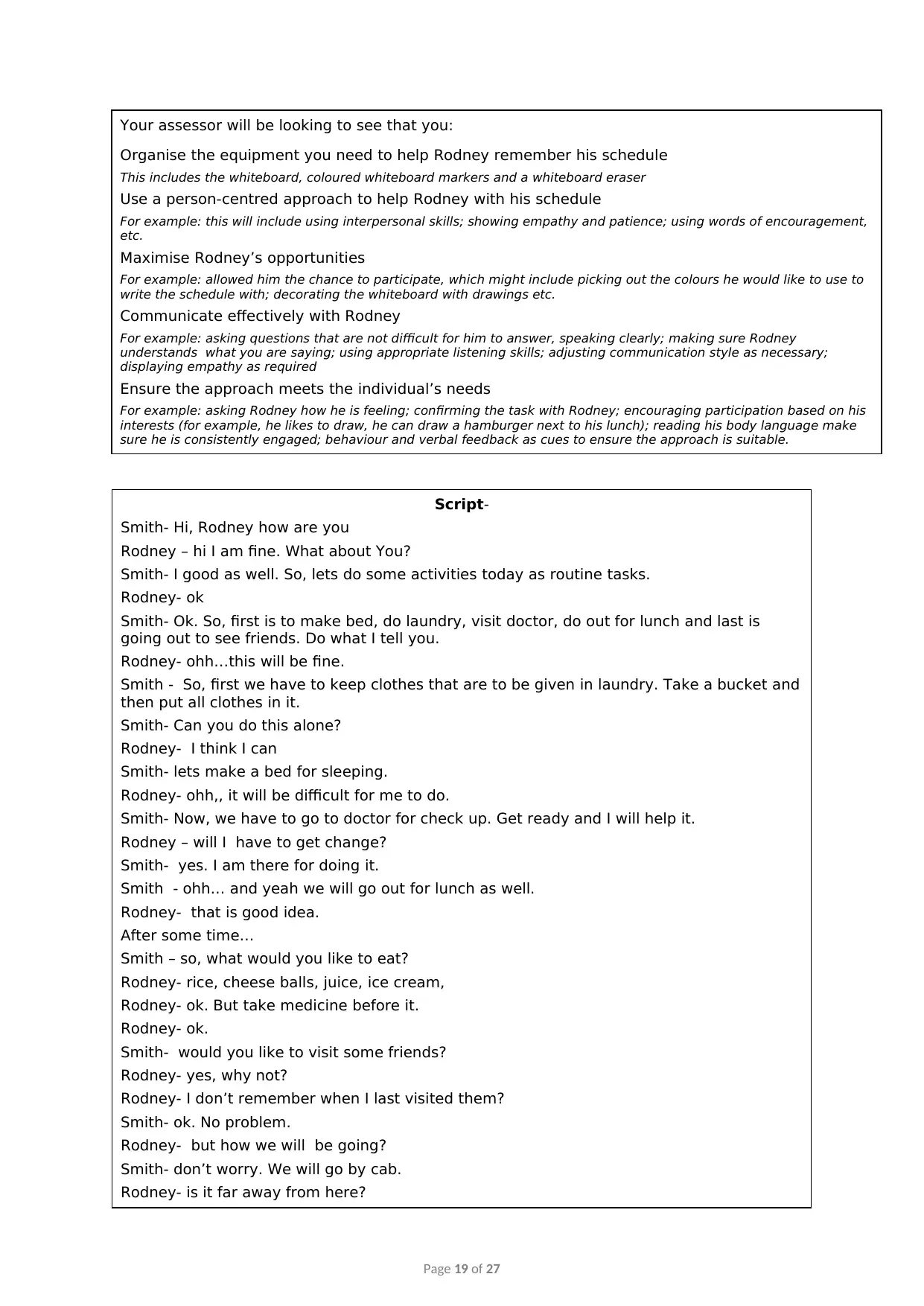
Your assessor will be looking to see that you:
Organise the equipment you need to help Rodney remember his schedule
This includes the whiteboard, coloured whiteboard markers and a whiteboard eraser
Use a person-centred approach to help Rodney with his schedule
For example: this will include using interpersonal skills; showing empathy and patience; using words of encouragement,
etc.
Maximise Rodney’s opportunities
For example: allowed him the chance to participate, which might include picking out the colours he would like to use to
write the schedule with; decorating the whiteboard with drawings etc.
Communicate effectively with Rodney
For example: asking questions that are not difficult for him to answer, speaking clearly; making sure Rodney
understands what you are saying; using appropriate listening skills; adjusting communication style as necessary;
displaying empathy as required
Ensure the approach meets the individual’s needs
For example: asking Rodney how he is feeling; confirming the task with Rodney; encouraging participation based on his
interests (for example, he likes to draw, he can draw a hamburger next to his lunch); reading his body language make
sure he is consistently engaged; behaviour and verbal feedback as cues to ensure the approach is suitable.
Script-
Smith- Hi, Rodney how are you
Rodney – hi I am fine. What about You?
Smith- I good as well. So, lets do some activities today as routine tasks.
Rodney- ok
Smith- Ok. So, first is to make bed, do laundry, visit doctor, do out for lunch and last is
going out to see friends. Do what I tell you.
Rodney- ohh…this will be fine.
Smith - So, first we have to keep clothes that are to be given in laundry. Take a bucket and
then put all clothes in it.
Smith- Can you do this alone?
Rodney- I think I can
Smith- lets make a bed for sleeping.
Rodney- ohh,, it will be difficult for me to do.
Smith- Now, we have to go to doctor for check up. Get ready and I will help it.
Rodney – will I have to get change?
Smith- yes. I am there for doing it.
Smith - ohh… and yeah we will go out for lunch as well.
Rodney- that is good idea.
After some time…
Smith – so, what would you like to eat?
Rodney- rice, cheese balls, juice, ice cream,
Rodney- ok. But take medicine before it.
Rodney- ok.
Smith- would you like to visit some friends?
Rodney- yes, why not?
Rodney- I don’t remember when I last visited them?
Smith- ok. No problem.
Rodney- but how we will be going?
Smith- don’t worry. We will go by cab.
Rodney- is it far away from here?
Page 19 of 27
Organise the equipment you need to help Rodney remember his schedule
This includes the whiteboard, coloured whiteboard markers and a whiteboard eraser
Use a person-centred approach to help Rodney with his schedule
For example: this will include using interpersonal skills; showing empathy and patience; using words of encouragement,
etc.
Maximise Rodney’s opportunities
For example: allowed him the chance to participate, which might include picking out the colours he would like to use to
write the schedule with; decorating the whiteboard with drawings etc.
Communicate effectively with Rodney
For example: asking questions that are not difficult for him to answer, speaking clearly; making sure Rodney
understands what you are saying; using appropriate listening skills; adjusting communication style as necessary;
displaying empathy as required
Ensure the approach meets the individual’s needs
For example: asking Rodney how he is feeling; confirming the task with Rodney; encouraging participation based on his
interests (for example, he likes to draw, he can draw a hamburger next to his lunch); reading his body language make
sure he is consistently engaged; behaviour and verbal feedback as cues to ensure the approach is suitable.
Script-
Smith- Hi, Rodney how are you
Rodney – hi I am fine. What about You?
Smith- I good as well. So, lets do some activities today as routine tasks.
Rodney- ok
Smith- Ok. So, first is to make bed, do laundry, visit doctor, do out for lunch and last is
going out to see friends. Do what I tell you.
Rodney- ohh…this will be fine.
Smith - So, first we have to keep clothes that are to be given in laundry. Take a bucket and
then put all clothes in it.
Smith- Can you do this alone?
Rodney- I think I can
Smith- lets make a bed for sleeping.
Rodney- ohh,, it will be difficult for me to do.
Smith- Now, we have to go to doctor for check up. Get ready and I will help it.
Rodney – will I have to get change?
Smith- yes. I am there for doing it.
Smith - ohh… and yeah we will go out for lunch as well.
Rodney- that is good idea.
After some time…
Smith – so, what would you like to eat?
Rodney- rice, cheese balls, juice, ice cream,
Rodney- ok. But take medicine before it.
Rodney- ok.
Smith- would you like to visit some friends?
Rodney- yes, why not?
Rodney- I don’t remember when I last visited them?
Smith- ok. No problem.
Rodney- but how we will be going?
Smith- don’t worry. We will go by cab.
Rodney- is it far away from here?
Page 19 of 27
Paraphrase This Document
Need a fresh take? Get an instant paraphrase of this document with our AI Paraphraser
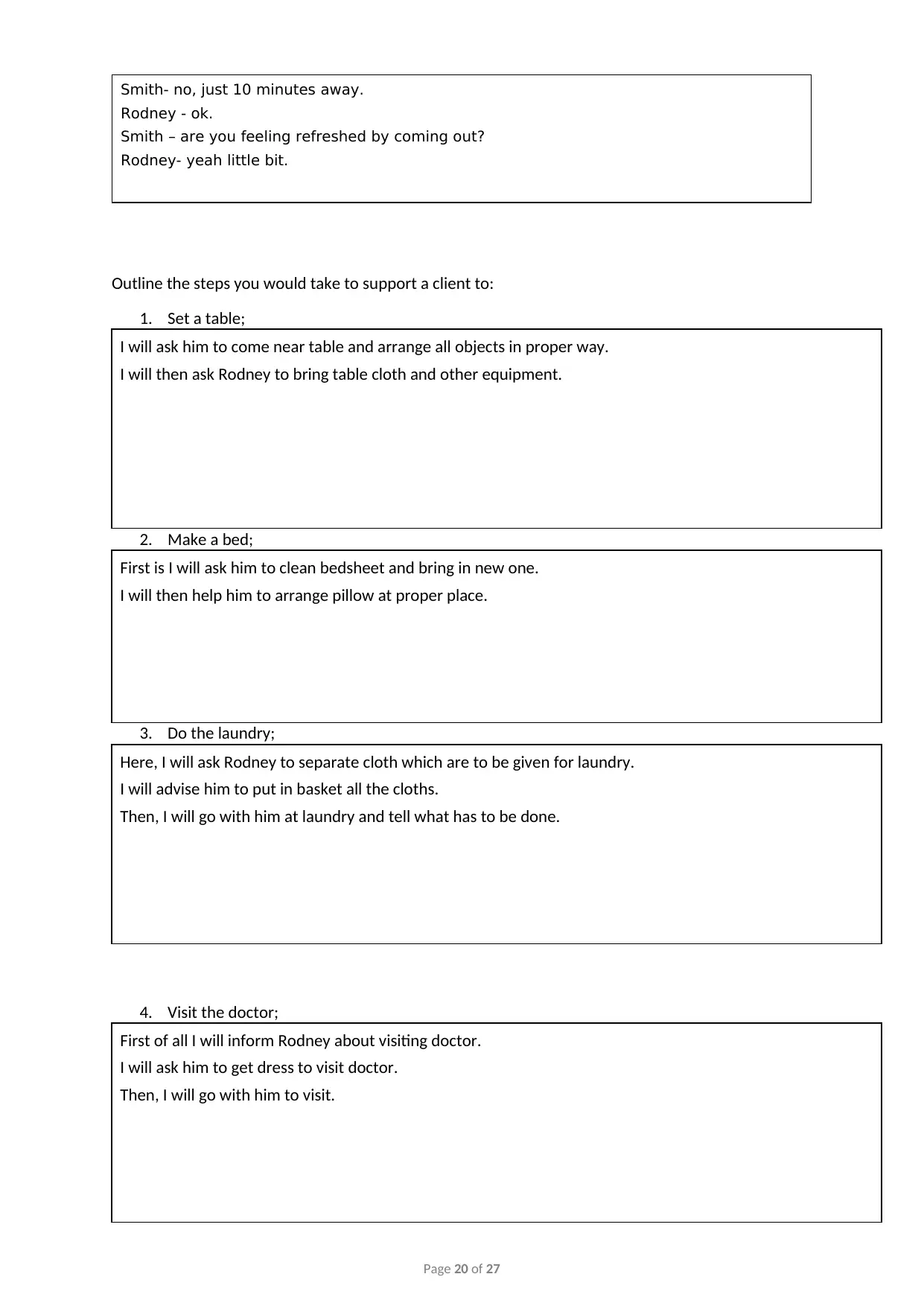
Smith- no, just 10 minutes away.
Rodney - ok.
Smith – are you feeling refreshed by coming out?
Rodney- yeah little bit.
Outline the steps you would take to support a client to:
1. Set a table;
I will ask him to come near table and arrange all objects in proper way.
I will then ask Rodney to bring table cloth and other equipment.
2. Make a bed;
First is I will ask him to clean bedsheet and bring in new one.
I will then help him to arrange pillow at proper place.
3. Do the laundry;
Here, I will ask Rodney to separate cloth which are to be given for laundry.
I will advise him to put in basket all the cloths.
Then, I will go with him at laundry and tell what has to be done.
4. Visit the doctor;
First of all I will inform Rodney about visiting doctor.
I will ask him to get dress to visit doctor.
Then, I will go with him to visit.
Page 20 of 27
Rodney - ok.
Smith – are you feeling refreshed by coming out?
Rodney- yeah little bit.
Outline the steps you would take to support a client to:
1. Set a table;
I will ask him to come near table and arrange all objects in proper way.
I will then ask Rodney to bring table cloth and other equipment.
2. Make a bed;
First is I will ask him to clean bedsheet and bring in new one.
I will then help him to arrange pillow at proper place.
3. Do the laundry;
Here, I will ask Rodney to separate cloth which are to be given for laundry.
I will advise him to put in basket all the cloths.
Then, I will go with him at laundry and tell what has to be done.
4. Visit the doctor;
First of all I will inform Rodney about visiting doctor.
I will ask him to get dress to visit doctor.
Then, I will go with him to visit.
Page 20 of 27
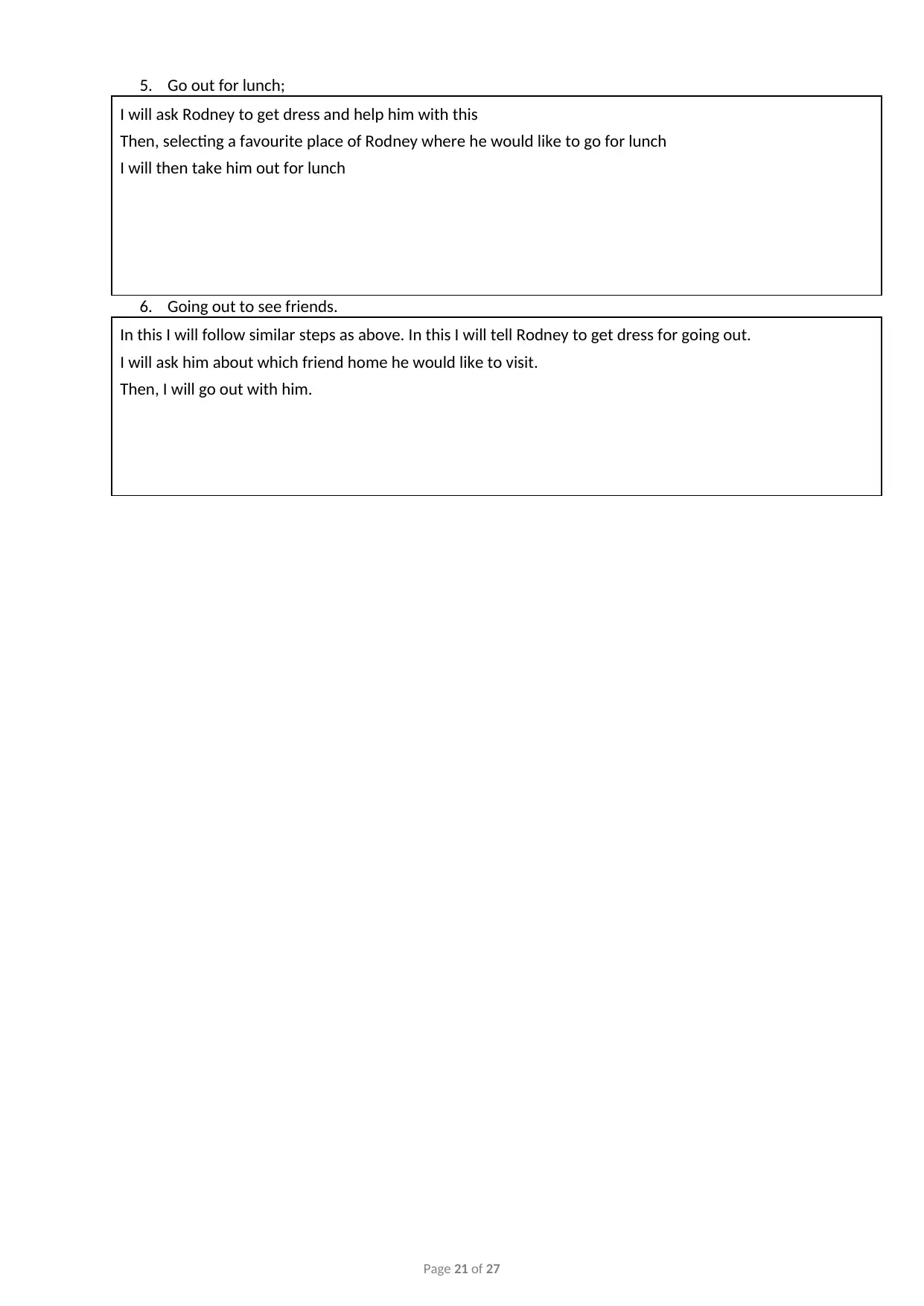
5. Go out for lunch;
I will ask Rodney to get dress and help him with this
Then, selecting a favourite place of Rodney where he would like to go for lunch
I will then take him out for lunch
6. Going out to see friends.
In this I will follow similar steps as above. In this I will tell Rodney to get dress for going out.
I will ask him about which friend home he would like to visit.
Then, I will go out with him.
Page 21 of 27
I will ask Rodney to get dress and help him with this
Then, selecting a favourite place of Rodney where he would like to go for lunch
I will then take him out for lunch
6. Going out to see friends.
In this I will follow similar steps as above. In this I will tell Rodney to get dress for going out.
I will ask him about which friend home he would like to visit.
Then, I will go out with him.
Page 21 of 27
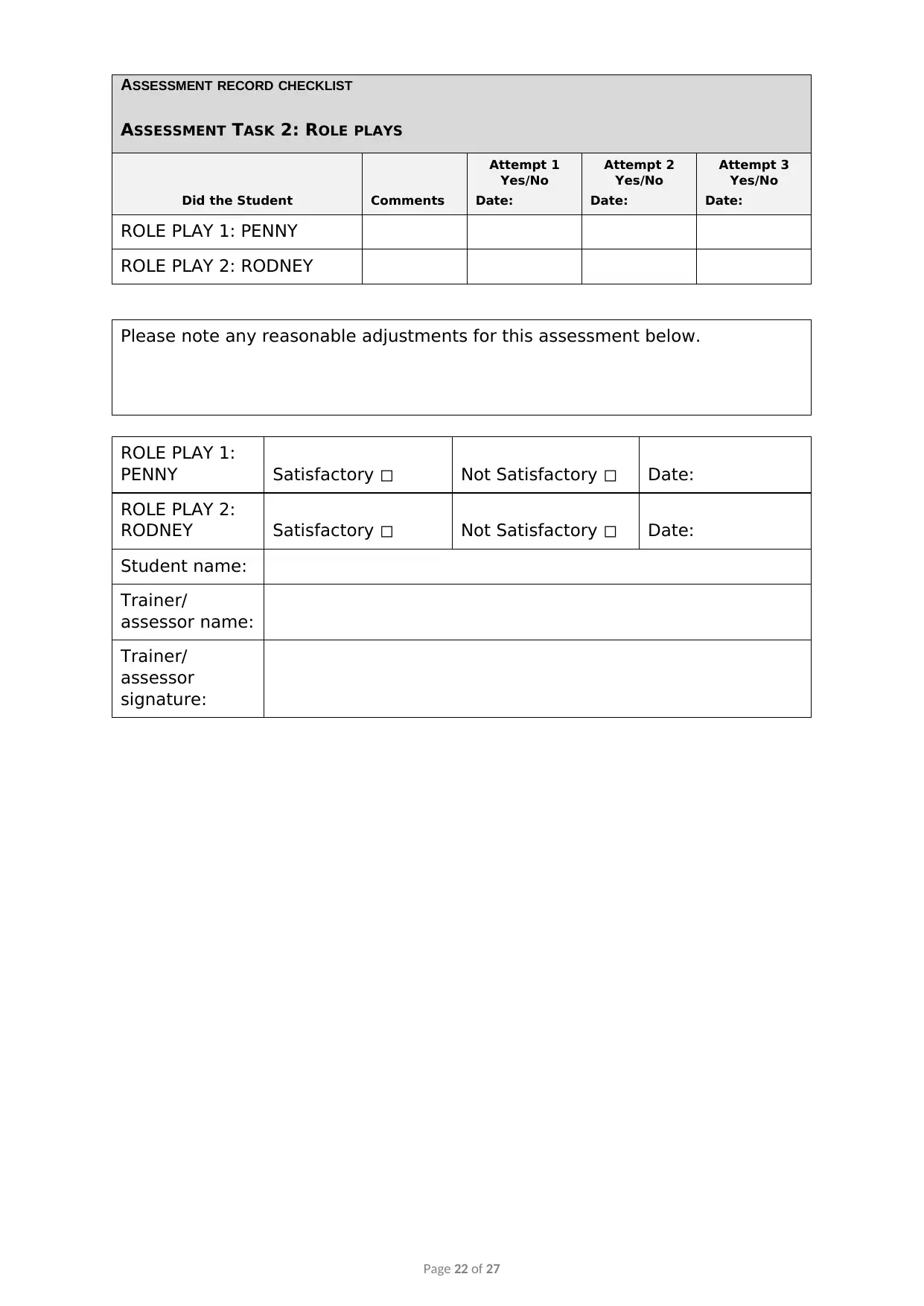
ASSESSMENT RECORD CHECKLIST
ASSESSMENT TASK 2: ROLE PLAYS
Did the Student Comments
Attempt 1
Yes/No
Date:
Attempt 2
Yes/No
Date:
Attempt 3
Yes/No
Date:
ROLE PLAY 1: PENNY
ROLE PLAY 2: RODNEY
Please note any reasonable adjustments for this assessment below.
ROLE PLAY 1:
PENNY Satisfactory ◻ Not Satisfactory ◻ Date:
ROLE PLAY 2:
RODNEY Satisfactory ◻ Not Satisfactory ◻ Date:
Student name:
Trainer/
assessor name:
Trainer/
assessor
signature:
Page 22 of 27
ASSESSMENT TASK 2: ROLE PLAYS
Did the Student Comments
Attempt 1
Yes/No
Date:
Attempt 2
Yes/No
Date:
Attempt 3
Yes/No
Date:
ROLE PLAY 1: PENNY
ROLE PLAY 2: RODNEY
Please note any reasonable adjustments for this assessment below.
ROLE PLAY 1:
PENNY Satisfactory ◻ Not Satisfactory ◻ Date:
ROLE PLAY 2:
RODNEY Satisfactory ◻ Not Satisfactory ◻ Date:
Student name:
Trainer/
assessor name:
Trainer/
assessor
signature:
Page 22 of 27
Secure Best Marks with AI Grader
Need help grading? Try our AI Grader for instant feedback on your assignments.

ASSESSMENT TASK 3: CASE STUDIES
TASK SUMMARY:
You are required to watch two separate videos that show examples of person-
centred strategies for people with a disability.
After watching each video, you will need to answer a set of questions.
WHAT DO I NEED IN ORDER TO COMPLETE THIS ASSESSMENT?
▪ Access to the Internet
▪ The video links provided for each case study (see below)
WHEN DO I DO THIS TASK?
▪ You will do this task in the classroom or as homework – your assessor will advise
▪ Write in the due date as advised by your assessor:
WHAT DO I NEED TO DO IF I GET SOMETHING WRONG?
If your assessor marks any of your answers as incorrect, they will talk to you about
resubmission. You will need to do one of the following:
▪ Answer the questions that were incorrect in writing.
▪ Answer the questions that were incorrect verbally.
INSTRUCTIONS:
Watch the video at the link below and then answer the questions for the case study. There
are two videos and case study questions to complete.
CASE STUDY 1: KATY
Watch the YouTube video Katy baking’ at https://youtu.be/WuDP2IWVvDc
When it is finished, answer the questions below.
1. Describe the approach used by the carer.
Here, person centred approach is being used by carer. The carer is able to understand and
deal with how Katy perceive herself and on basis of that she is dealing with her. Also, she is
easily able to interpret thoughts of Katy. In that it is seen that the carer is helping Katy to
cook food. So, she is helping her in mixing of eggs and pouring oil in vessel.
2. Was the approach effective or ineffective? Explain your answer.
Page 23 of 27
TASK SUMMARY:
You are required to watch two separate videos that show examples of person-
centred strategies for people with a disability.
After watching each video, you will need to answer a set of questions.
WHAT DO I NEED IN ORDER TO COMPLETE THIS ASSESSMENT?
▪ Access to the Internet
▪ The video links provided for each case study (see below)
WHEN DO I DO THIS TASK?
▪ You will do this task in the classroom or as homework – your assessor will advise
▪ Write in the due date as advised by your assessor:
WHAT DO I NEED TO DO IF I GET SOMETHING WRONG?
If your assessor marks any of your answers as incorrect, they will talk to you about
resubmission. You will need to do one of the following:
▪ Answer the questions that were incorrect in writing.
▪ Answer the questions that were incorrect verbally.
INSTRUCTIONS:
Watch the video at the link below and then answer the questions for the case study. There
are two videos and case study questions to complete.
CASE STUDY 1: KATY
Watch the YouTube video Katy baking’ at https://youtu.be/WuDP2IWVvDc
When it is finished, answer the questions below.
1. Describe the approach used by the carer.
Here, person centred approach is being used by carer. The carer is able to understand and
deal with how Katy perceive herself and on basis of that she is dealing with her. Also, she is
easily able to interpret thoughts of Katy. In that it is seen that the carer is helping Katy to
cook food. So, she is helping her in mixing of eggs and pouring oil in vessel.
2. Was the approach effective or ineffective? Explain your answer.
Page 23 of 27
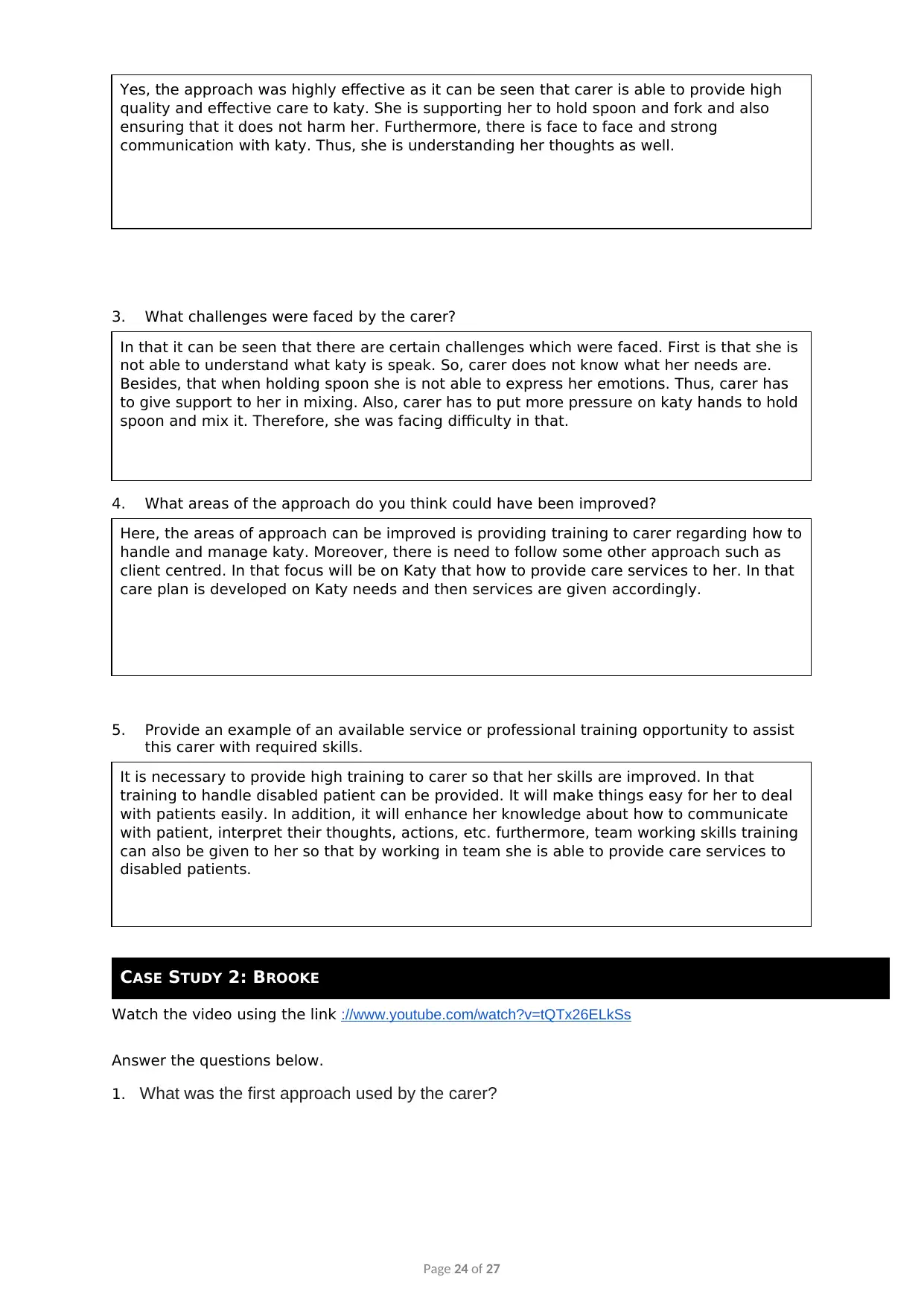
Yes, the approach was highly effective as it can be seen that carer is able to provide high
quality and effective care to katy. She is supporting her to hold spoon and fork and also
ensuring that it does not harm her. Furthermore, there is face to face and strong
communication with katy. Thus, she is understanding her thoughts as well.
3. What challenges were faced by the carer?
In that it can be seen that there are certain challenges which were faced. First is that she is
not able to understand what katy is speak. So, carer does not know what her needs are.
Besides, that when holding spoon she is not able to express her emotions. Thus, carer has
to give support to her in mixing. Also, carer has to put more pressure on katy hands to hold
spoon and mix it. Therefore, she was facing difficulty in that.
4. What areas of the approach do you think could have been improved?
Here, the areas of approach can be improved is providing training to carer regarding how to
handle and manage katy. Moreover, there is need to follow some other approach such as
client centred. In that focus will be on Katy that how to provide care services to her. In that
care plan is developed on Katy needs and then services are given accordingly.
5. Provide an example of an available service or professional training opportunity to assist
this carer with required skills.
It is necessary to provide high training to carer so that her skills are improved. In that
training to handle disabled patient can be provided. It will make things easy for her to deal
with patients easily. In addition, it will enhance her knowledge about how to communicate
with patient, interpret their thoughts, actions, etc. furthermore, team working skills training
can also be given to her so that by working in team she is able to provide care services to
disabled patients.
CASE STUDY 2: BROOKE
Watch the video using the link ://www.youtube.com/watch?v=tQTx26ELkSs
Answer the questions below.
1. What was the first approach used by the carer?
Page 24 of 27
quality and effective care to katy. She is supporting her to hold spoon and fork and also
ensuring that it does not harm her. Furthermore, there is face to face and strong
communication with katy. Thus, she is understanding her thoughts as well.
3. What challenges were faced by the carer?
In that it can be seen that there are certain challenges which were faced. First is that she is
not able to understand what katy is speak. So, carer does not know what her needs are.
Besides, that when holding spoon she is not able to express her emotions. Thus, carer has
to give support to her in mixing. Also, carer has to put more pressure on katy hands to hold
spoon and mix it. Therefore, she was facing difficulty in that.
4. What areas of the approach do you think could have been improved?
Here, the areas of approach can be improved is providing training to carer regarding how to
handle and manage katy. Moreover, there is need to follow some other approach such as
client centred. In that focus will be on Katy that how to provide care services to her. In that
care plan is developed on Katy needs and then services are given accordingly.
5. Provide an example of an available service or professional training opportunity to assist
this carer with required skills.
It is necessary to provide high training to carer so that her skills are improved. In that
training to handle disabled patient can be provided. It will make things easy for her to deal
with patients easily. In addition, it will enhance her knowledge about how to communicate
with patient, interpret their thoughts, actions, etc. furthermore, team working skills training
can also be given to her so that by working in team she is able to provide care services to
disabled patients.
CASE STUDY 2: BROOKE
Watch the video using the link ://www.youtube.com/watch?v=tQTx26ELkSs
Answer the questions below.
1. What was the first approach used by the carer?
Page 24 of 27
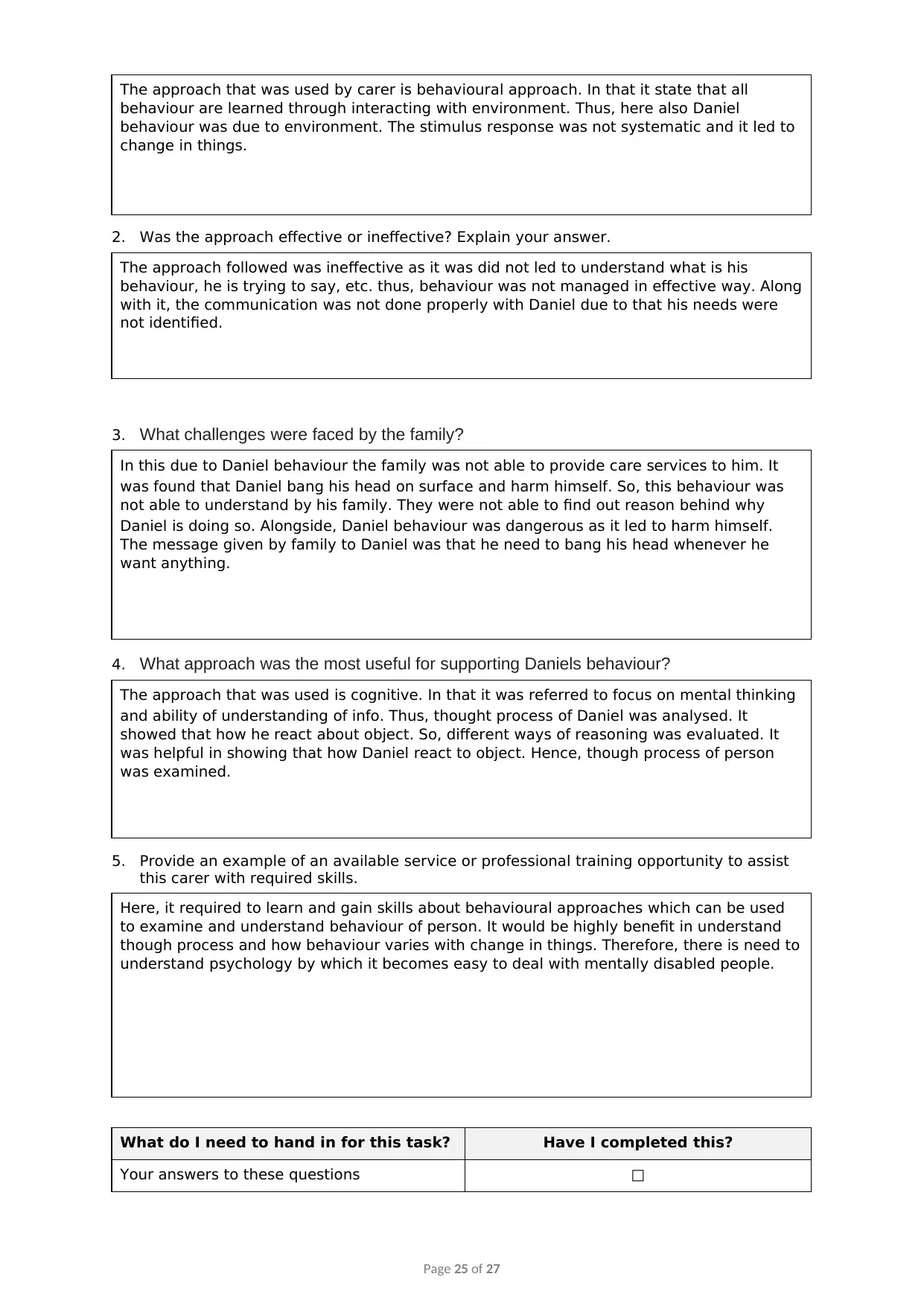
The approach that was used by carer is behavioural approach. In that it state that all
behaviour are learned through interacting with environment. Thus, here also Daniel
behaviour was due to environment. The stimulus response was not systematic and it led to
change in things.
2. Was the approach effective or ineffective? Explain your answer.
The approach followed was ineffective as it was did not led to understand what is his
behaviour, he is trying to say, etc. thus, behaviour was not managed in effective way. Along
with it, the communication was not done properly with Daniel due to that his needs were
not identified.
3. What challenges were faced by the family?
In this due to Daniel behaviour the family was not able to provide care services to him. It
was found that Daniel bang his head on surface and harm himself. So, this behaviour was
not able to understand by his family. They were not able to find out reason behind why
Daniel is doing so. Alongside, Daniel behaviour was dangerous as it led to harm himself.
The message given by family to Daniel was that he need to bang his head whenever he
want anything.
4. What approach was the most useful for supporting Daniels behaviour?
The approach that was used is cognitive. In that it was referred to focus on mental thinking
and ability of understanding of info. Thus, thought process of Daniel was analysed. It
showed that how he react about object. So, different ways of reasoning was evaluated. It
was helpful in showing that how Daniel react to object. Hence, though process of person
was examined.
5. Provide an example of an available service or professional training opportunity to assist
this carer with required skills.
Here, it required to learn and gain skills about behavioural approaches which can be used
to examine and understand behaviour of person. It would be highly benefit in understand
though process and how behaviour varies with change in things. Therefore, there is need to
understand psychology by which it becomes easy to deal with mentally disabled people.
What do I need to hand in for this task? Have I completed this?
Your answers to these questions □
Page 25 of 27
behaviour are learned through interacting with environment. Thus, here also Daniel
behaviour was due to environment. The stimulus response was not systematic and it led to
change in things.
2. Was the approach effective or ineffective? Explain your answer.
The approach followed was ineffective as it was did not led to understand what is his
behaviour, he is trying to say, etc. thus, behaviour was not managed in effective way. Along
with it, the communication was not done properly with Daniel due to that his needs were
not identified.
3. What challenges were faced by the family?
In this due to Daniel behaviour the family was not able to provide care services to him. It
was found that Daniel bang his head on surface and harm himself. So, this behaviour was
not able to understand by his family. They were not able to find out reason behind why
Daniel is doing so. Alongside, Daniel behaviour was dangerous as it led to harm himself.
The message given by family to Daniel was that he need to bang his head whenever he
want anything.
4. What approach was the most useful for supporting Daniels behaviour?
The approach that was used is cognitive. In that it was referred to focus on mental thinking
and ability of understanding of info. Thus, thought process of Daniel was analysed. It
showed that how he react about object. So, different ways of reasoning was evaluated. It
was helpful in showing that how Daniel react to object. Hence, though process of person
was examined.
5. Provide an example of an available service or professional training opportunity to assist
this carer with required skills.
Here, it required to learn and gain skills about behavioural approaches which can be used
to examine and understand behaviour of person. It would be highly benefit in understand
though process and how behaviour varies with change in things. Therefore, there is need to
understand psychology by which it becomes easy to deal with mentally disabled people.
What do I need to hand in for this task? Have I completed this?
Your answers to these questions □
Page 25 of 27
Paraphrase This Document
Need a fresh take? Get an instant paraphrase of this document with our AI Paraphraser
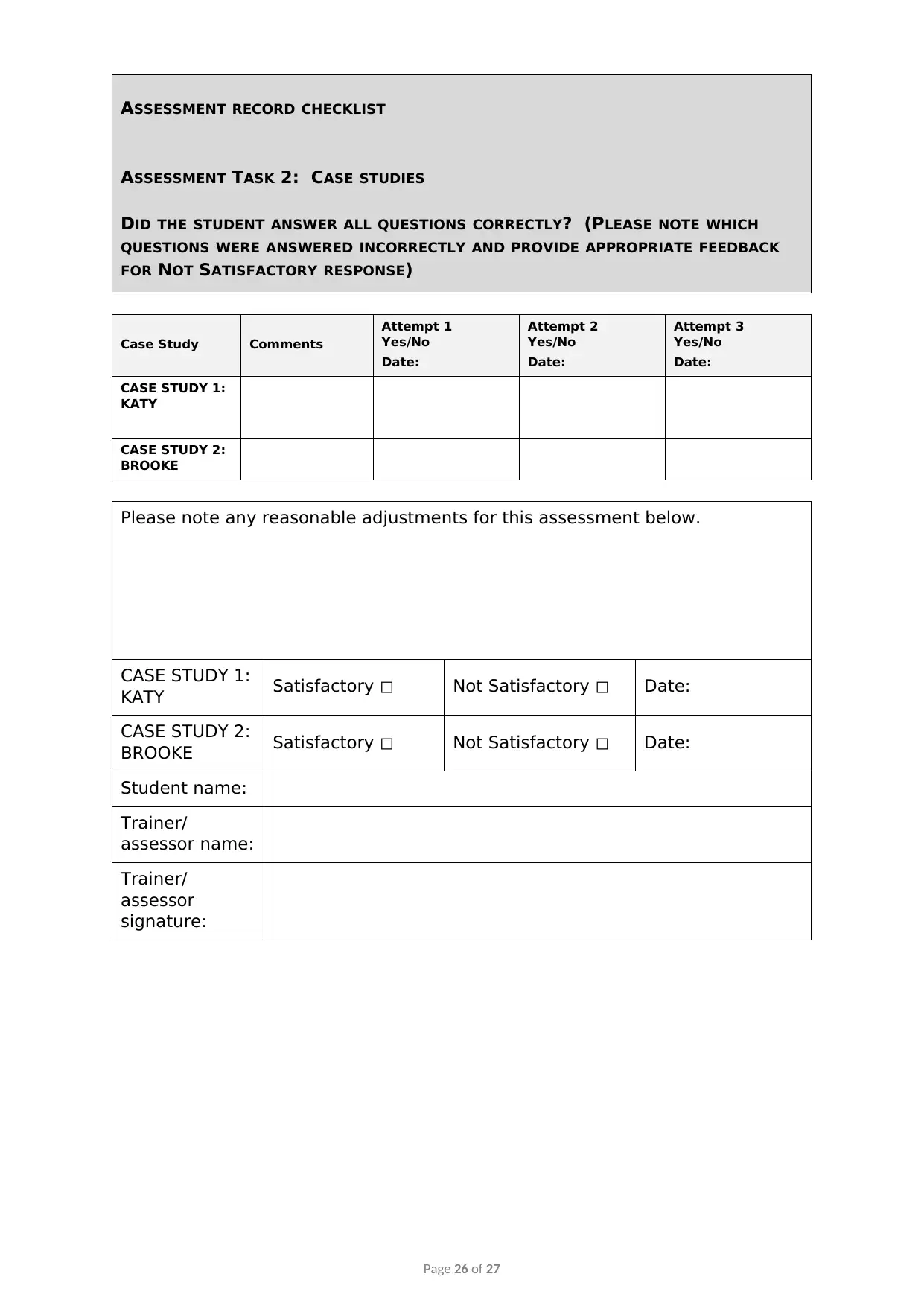
ASSESSMENT RECORD CHECKLIST
ASSESSMENT TASK 2: CASE STUDIES
DID THE STUDENT ANSWER ALL QUESTIONS CORRECTLY? (PLEASE NOTE WHICH
QUESTIONS WERE ANSWERED INCORRECTLY AND PROVIDE APPROPRIATE FEEDBACK
FOR NOT SATISFACTORY RESPONSE)
Case Study Comments
Attempt 1
Yes/No
Date:
Attempt 2
Yes/No
Date:
Attempt 3
Yes/No
Date:
CASE STUDY 1:
KATY
CASE STUDY 2:
BROOKE
Please note any reasonable adjustments for this assessment below.
CASE STUDY 1:
KATY Satisfactory ◻ Not Satisfactory ◻ Date:
CASE STUDY 2:
BROOKE Satisfactory ◻ Not Satisfactory ◻ Date:
Student name:
Trainer/
assessor name:
Trainer/
assessor
signature:
Page 26 of 27
ASSESSMENT TASK 2: CASE STUDIES
DID THE STUDENT ANSWER ALL QUESTIONS CORRECTLY? (PLEASE NOTE WHICH
QUESTIONS WERE ANSWERED INCORRECTLY AND PROVIDE APPROPRIATE FEEDBACK
FOR NOT SATISFACTORY RESPONSE)
Case Study Comments
Attempt 1
Yes/No
Date:
Attempt 2
Yes/No
Date:
Attempt 3
Yes/No
Date:
CASE STUDY 1:
KATY
CASE STUDY 2:
BROOKE
Please note any reasonable adjustments for this assessment below.
CASE STUDY 1:
KATY Satisfactory ◻ Not Satisfactory ◻ Date:
CASE STUDY 2:
BROOKE Satisfactory ◻ Not Satisfactory ◻ Date:
Student name:
Trainer/
assessor name:
Trainer/
assessor
signature:
Page 26 of 27
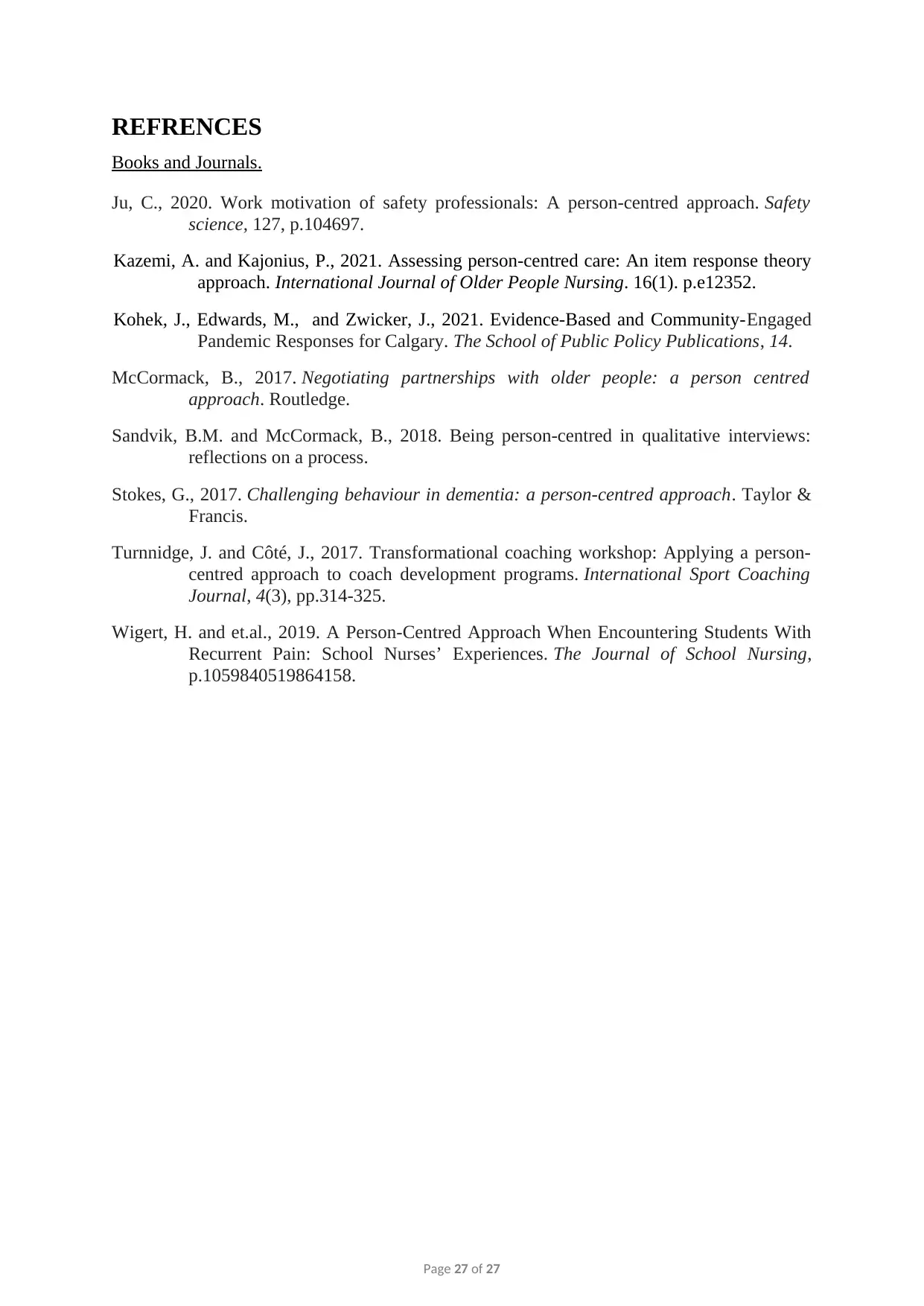
REFRENCES
Books and Journals.
Ju, C., 2020. Work motivation of safety professionals: A person-centred approach. Safety
science, 127, p.104697.
Kazemi, A. and Kajonius, P., 2021. Assessing person‐centred care: An item response theory
approach. International Journal of Older People Nursing. 16(1). p.e12352.
Kohek, J., Edwards, M., and Zwicker, J., 2021. Evidence-Based and Community-Engaged
Pandemic Responses for Calgary. The School of Public Policy Publications, 14.
McCormack, B., 2017. Negotiating partnerships with older people: a person centred
approach. Routledge.
Sandvik, B.M. and McCormack, B., 2018. Being person-centred in qualitative interviews:
reflections on a process.
Stokes, G., 2017. Challenging behaviour in dementia: a person-centred approach. Taylor &
Francis.
Turnnidge, J. and Côté, J., 2017. Transformational coaching workshop: Applying a person-
centred approach to coach development programs. International Sport Coaching
Journal, 4(3), pp.314-325.
Wigert, H. and et.al., 2019. A Person-Centred Approach When Encountering Students With
Recurrent Pain: School Nurses’ Experiences. The Journal of School Nursing,
p.1059840519864158.
Page 27 of 27
Books and Journals.
Ju, C., 2020. Work motivation of safety professionals: A person-centred approach. Safety
science, 127, p.104697.
Kazemi, A. and Kajonius, P., 2021. Assessing person‐centred care: An item response theory
approach. International Journal of Older People Nursing. 16(1). p.e12352.
Kohek, J., Edwards, M., and Zwicker, J., 2021. Evidence-Based and Community-Engaged
Pandemic Responses for Calgary. The School of Public Policy Publications, 14.
McCormack, B., 2017. Negotiating partnerships with older people: a person centred
approach. Routledge.
Sandvik, B.M. and McCormack, B., 2018. Being person-centred in qualitative interviews:
reflections on a process.
Stokes, G., 2017. Challenging behaviour in dementia: a person-centred approach. Taylor &
Francis.
Turnnidge, J. and Côté, J., 2017. Transformational coaching workshop: Applying a person-
centred approach to coach development programs. International Sport Coaching
Journal, 4(3), pp.314-325.
Wigert, H. and et.al., 2019. A Person-Centred Approach When Encountering Students With
Recurrent Pain: School Nurses’ Experiences. The Journal of School Nursing,
p.1059840519864158.
Page 27 of 27
1 out of 27
Related Documents
Your All-in-One AI-Powered Toolkit for Academic Success.
+13062052269
info@desklib.com
Available 24*7 on WhatsApp / Email
![[object Object]](/_next/static/media/star-bottom.7253800d.svg)
Unlock your academic potential
© 2024 | Zucol Services PVT LTD | All rights reserved.





